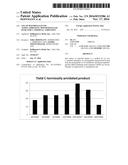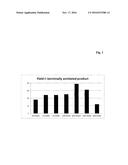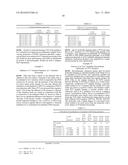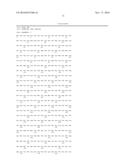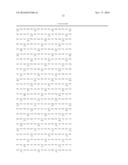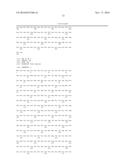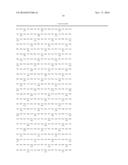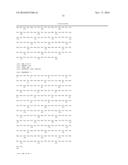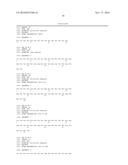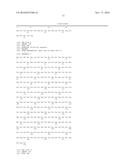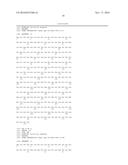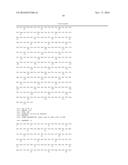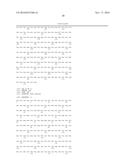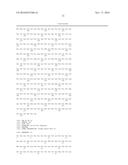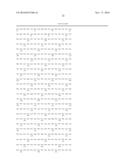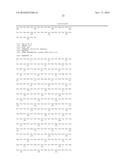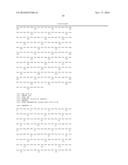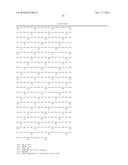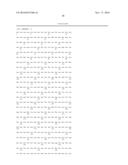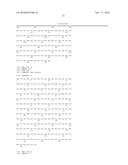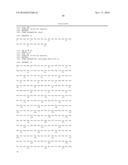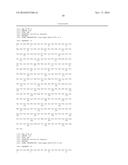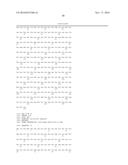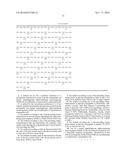Patent application title: USE OF PEPTIDYLGLYCINE ALPHA-AMIDATING MONOOXIGENASE (PAM) FOR C-TERMINAL AMIDATION
Inventors:
Eike Hoffmann (Herrsching A. Ammersee, DE)
Georg Tiefenthaler (Sindelsdorf, DE)
Georg Tiefenthaler (Sindelsdorf, DE)
Assignees:
Hoffmann-La Roche Inc.
IPC8 Class: AC12P2102FI
USPC Class:
1 1
Class name:
Publication date: 2016-11-17
Patent application number: 20160333386
Abstract:
One aspect as reported herein is a method for in vivo C-terminal
amidation of a polypeptide characterized in that both the polypeptide (to
be amidated) and human peptidylglycine alpha-amidating monooxigenase
(PAM) are recombinantly co-expressed in a mammalian cell.Claims:
1. A method for in vivo C-terminal amidation of a polypeptide
characterized in that both the polypeptide and human peptidylglycine
alpha-amidating monooxigenase (PAM) are recombinantly co-expressed in a
mammalian cell.
2. A method for the recombinant production of a C-terminally amidated polypeptide characterized in that both the polypeptide and human peptidylglycine alpha-amidating monooxigenase (PAM) are recombinantly co-expressed in a mammalian cell.
3. The method according to any of the preceding claims, characterized in that the human peptidylglycine alpha-amidating monooxigenase (PAM) is a PAM 3 (SEQ ID NO: 02).
4. The method according to any of the preceding claims, characterized in that the mammalian cell comprises a first nucleic acid encoding the polypeptide and a second nucleic acid encoding the PAM.
5. The method according to claim 4, characterized in that the ratio of the first nucleic acid to the second nucleic acid is from about 90:10 to about 40:60.
6. The method according claim 4, characterized in that the ratio of the first nucleic acid to the second nucleic acid is from about 70:30 to about 60:40.
7. The method according to any of the preceding claims, characterized in that the polypeptide is fused to the C-Terminus of an antibody heavy chain or the Fc region thereof.
8. The method according any of the preceding claims, characterized in that the polypeptide is Neurokinin, Allatostatin, Lem-KI, TRH, Red Pigment Concentrating Hormone, Calcitonin, CRF, LHRH, Leucopyrokinin, Gastrin I, Pigment Dispersing Hormone, Dermorphin, Oxytocin, Substance P, NPY, FMRFamide, Bombesin, Amylin, [Arg.sup.8]Vasopressin, BId-GrTH, Calcitonin, Cam-HrTH-II, Gastrin Releasing Peptide, Neuromedin B, Pancreastatin, Conotoxin M1, Secretin, GHRF, Melittin, Sarcotoxin 1A, VIP, .alpha.-MSH or MIF-1.
9. The method according any of the preceding claims, characterized in that the polypeptide is peptide YY (PYY 3-36) of SEQ ID NO: 05.
10. Use of a human peptidylglycine alpha-amidating monooxigenase (PAM) for the recombinant production of a C-terminally amidated polypeptide, characterized in that both the polypeptide and the human PAM are recombinantly co-expressed in a mammalian cell.
Description:
CROSS REFERENCE TO RELATED APPLICATIONS
[0001] This application is a continuation of International Application No. PCT/EP2014/077143 having an international filing date of Dec. 10, 2014, the entire contents of which are incorporated herein by reference, and which claims benefit under 35 U.S.C. .sctn.119 to European Patent Application No. 13199222.4 filed Dec. 20, 2013.
SEQUENCE LISTING
[0002] The instant application contains a Sequence Listing submitted via EFS-Web and hereby incorporated by reference in its entirety. Said ASCII copy, created on Jun. 15, 2016, is named P31912US1Seqlist.txt, and 61,892 bytes in size.
FIELD OF INVENTION
[0003] The current invention is in the field of recombinant polypeptide production. Herein is reported a method for obtaining a C-terminally amidated polypeptide using human peptidylglycine alpha-amidating monooxigenase (PAM) in vivo.
BACKGROUND OF THE INVENTION
[0004] In recent years the production of proteins has steadily increased and it is likely that proteins will become the biggest group of therapeutics available for the treatment of various diseases in the near future. The impact of proteins emerges from their specificity, such as the specific target recognition and binding function.
[0005] Cell cultures are used in fermentative processes to produce substances, in particular proteins. A distinction is made between processes in which the cell cultures are genetically unmodified and form their own metabolic products, and processes in which the organisms are genetically modified in such a manner that they either produce a larger amount of their own substances such as proteins, or produce substances which they do not produce without said modification, e.g. foreign (heterologous) substances.
[0006] More than half of the bioreactive neuropeptides and peptide hormones are amidated at their C-terminus. The synthesis normally occurs in endocrine, neuronal or other specifically differentiated secretory cells. The biosynthetic precursor for the amidated peptide is a C-terminally glycine-extended intermediate. The glycine-extended intermediate is usually generated from a larger precursor through an initial endoproteolytic cleavage at a processing site (generally composed of one or more basic amino acids). Thereafter the C-terminal basic residues are removed by a specific carboxypeptidase (for review see e.g. Bradbury, A. F. and Smyth, D. G., TIBS16 (1991) 112-115).
[0007] The (.alpha.-) amidating activity comprises two distinct enzymatic activities, a hydroxylase step and a lyase step mediated by a peptidyl-glycine .alpha.-amidating monooxygenase (PAM).
[0008] Wulf, B. S., et al. (Mol. Cell. Endocrin. 91 (1993) 135-141) report that efficient amidation of C-peptide deleted NPY precursors by non-endocrine cells is affected by the presence of Lys-Arg at the C-terminus. Tateishi, K. et al. (Biochem. Biophys. Res. Com. 205 (1994) 282-290) report the isolation and functional expression of human pancreatic peptidylglycine alpha-amidating monooxigenase. Takahashi, K.-Y. et al. (Peptides 18 (1996) 439-444) report the production of bioactive Salmon Calcitonin from COS-7 and CHO cells. Cloning, co-expression with an amidating enzyme, and activity of the scorpion toxin Bmk ITa1 cDNA in insect cells is reported by Liu, Z., et al. (Mol. Biotechnol. 24 (2003) 21-26). Manabu Satani et al. (Protein Express Purif. 28 (2003) 293-302) describe the expression and characterization of human bifunctional peptidylglycine alpha-amidating monooxigenase. C-terminal .alpha.-amidation is reported by Nozer M. Metha et al. (Post-translational modification of protein pharmaceuticals (2009) 253-276).
SUMMARY OF THE INVENTION
[0009] It has been found that it is advantageous to use a certain ratio of (to be amidated) polypeptide encoding nucleic acid to PAM encoding nucleic acid to achieve a beneficial ratio of C-terminal amidation to yield of produced polypeptide.
[0010] Furthermore, is was found to not be a difference with respect to amidation and yield, if a membrane associated version of PAM was used (PAM2) or a transmembrane domain-depleted, soluble version of PAM (PAM 3).
[0011] One aspect as reported herein is a method for in vivo C-terminal amidation of a polypeptide characterized in that both the polypeptide (to be amidated) and human peptidylglycine alpha-amidating monooxigenase (PAM) are recombinantly co-expressed (co-expressed in a recombinant manner) in a mammalian cell.
[0012] One aspect as reported herein is a method for the recombinant production of a C-terminally amidated polypeptide characterized in that both the polypeptide and human peptidylglycine alpha-amidating monooxigenase (PAM) are recombinantly co-expressed (co-expressed in a recombinant manner) in a mammalian cell.
[0013] In one preferred embodiment of all aspects the human peptidylglycine alpha-amidating monooxigenase (PAM) is a PAM 3 (SEQ ID NO: 02).
[0014] In one embodiment of all aspects the mammalian cell is co-transfected with a first vector comprising an expression cassette comprising a nucleic acid encoding the polypeptide (to be amidated) and a second vector comprising an expression cassette comprising a nucleic acid encoding the PAM.
[0015] In one embodiment of all aspects the ratio of the first vector to the second vector is from about 90:10 to about 40:60. In one embodiment of all aspects the ratio of the first vector to the second vector is from about 70:30 to about 60:40. In one preferred embodiment of all aspects the ratio of the first vector to the second vector is from about 70:30 to about 60:40 and the human peptidylglycine alpha-amidating monooxigenase (PAM) is a PAM 3 (SEQ ID NO: 02).
[0016] In one embodiment of all aspects the mammalian cell comprises a first nucleic acid encoding the polypeptide and a second nucleic acid encoding the PAM.
[0017] In one embodiment of all aspects the ratio of the first nucleic acid to the second nucleic acid is from about 90:10 to about 40:60. In one embodiment of all aspects the ratio of the first nucleic acid to the second nucleic acid is from about 70:30 to about 60:40. In one preferred embodiment of all aspects the ratio of the first nucleic acid to the second nucleic acid is from about 70:30 to about 60:40. and the human peptidylglycine alpha-amidating monooxigenase (PAM) is a PAM 3 (SEQ ID NO: 02).
[0018] In one embodiment of all aspects a first mammalian cell comprising a nucleic acid encoding the polypeptide and a second mammalian cell comprising a nucleic acid encoding the PAM is used for co-expression.
[0019] In one embodiment of all aspects the ratio of the first mammalian cell to the second mammalian cell is from about 90:10 to about 40:60. In one embodiment of all aspects the ratio of the first mammalian cell to the second mammalian cell is from about 70:30 to about 60:40.
[0020] In one embodiment of all aspects the polypeptide is fused to the C-Terminus of an antibody heavy chain or the Fc region thereof.
[0021] In one embodiment of all aspects the polypeptide is Neurokinin, Allatostatin, Lem-KI, TRH, Red Pigment Concentrating Hormone, Calcitonin, CRF, LHRH, Leucopyrokinin, Gastrin I, Pigment Dispersing Hormone, Dermorphin, Oxytocin, Substance P, NPY, FMRFamide, Bombesin, Amylin, [Arg.sup.8]Vasopressin, BId-GrTH, Calcitonin, Cam-HrTH-II, Gastrin Releasing Peptide, Neuromedin B, Pancreastatin, Conotoxin M1, Secretin, GHRF, Melittin, Sarcotoxin 1A, VIP, .alpha.-MSH or MIF-1. In one embodiment of all aspects the polypeptide is peptide YY (PYY 3-36) of SEQ ID NO: 05.
[0022] One aspect as reported herein is a use of a human peptidylglycine alpha-amidating monooxigenase (PAM) for the recombinant production of a C-terminally amidated polypeptide, characterized in that both the polypeptide (to be amidated) and the human PAM are co-expressed in a recombinant manner in a mammalian cell.
BRIEF DESCRIPTION OF THE SEQUENCES
[0023] SEQ ID NO: 01 Amino acid sequence of human PAM2
[0024] SEQ ID NO: 02 Amino acid sequence of human PAM3
[0025] SEQ ID NO: 03 Amino acid sequence of the human IgG1 Fc part
[0026] SEQ ID NO: 04 Amino acid sequence of G4Sx3 linker
[0027] SEQ ID NO: 05 Amino acid sequence of Peptide YY (PYY) 3-36
[0028] SEQ ID NO: 06 Amino acid sequence of Peptide YY (PYY) 3-36 plus glycine (G) at the C-terminus
[0029] SEQ ID NO: 07 Amino acid sequence of Peptide YY (PYY) 3-36 plus glycine (G) and lysine (K) at the C-terminus
[0030] SEQ ID NO: 08 Amino acid sequence of Peptide YY (PYY) 3-36 plus glycine (G) and lysine (K) and arginine (R) at the C-terminus
[0031] SEQ ID NO: 09 Amino acid sequence of fusion protein of a human IgG1 Fc part and a G4Sx3 linker and Peptide YY (PYY) 3-36
[0032] SEQ ID NO: 10 Amino acid sequence of fusion protein of a human IgG1 Fc part and a G4Sx3 linker and Peptide YY (PYY) 3-36 plus glycine (G) at the C-terminus
[0033] SEQ ID NO: 11 Amino acid sequence of fusion protein of a human IgG1 Fc part and a G4Sx3 linker and Peptide YY (PYY) 3-36 plus glycine (G) and lysine (K) at the C-terminus
[0034] SEQ ID NO: 12 Amino acid sequence of fusion protein of a human IgG1 Fc part and a G4Sx3 linker and Peptide YY (PYY) 3-36 plus glycine (G) and lysine (K) and arginine (R) at the C-terminus
[0035] SEQ ID NO: 13 Amino acid sequence of a human IgG1 heavy chain SEQ ID NO: 14 Amino acid sequence of fusion protein of a human IgG1 heavy chain and a G4Sx3 linker and Peptide YY (PYY) 3-36
[0036] SEQ ID NO: 15 Amino acid sequence of fusion protein of a human IgG1 heavy chain and a G4Sx3 linker and Peptide YY (PYY) 3-36 plus glycine (G) at the C-terminus
[0037] SEQ ID NO: 16 Amino acid sequence of fusion protein of a human IgG1 heavy chain and a G4Sx3 linker and Peptide YY (PYY) 3-36 plus glycine (G) and lysine (K) at the C-terminus
[0038] SEQ ID NO: 17 Amino acid sequence of fusion protein of a human IgG1 heavy chain and a G4Sx3 linker and Peptide YY (PYY) 3-36 plus glycine (G) and lysine (K) and arginine (R) at the C-terminus
[0039] SEQ ID NO: 18 Amino acid sequence of a human kappa light chain
[0040] SEQ ID NO: 19 Amino acid sequence of G4Sx5 linker
[0041] SEQ ID NO: 20 Amino acid sequence of fusion protein of a human kappa light chain and a G4Sx5 linker and Peptide YY (PYY) 3-36
[0042] SEQ ID NO: 21 Amino acid sequence of fusion protein of a human kappa light chain and a G4Sx5 linker and Peptide YY (PYY) 3-36 plus glycine (G) at the C-terminus
[0043] SEQ ID NO: 22 Amino acid sequence of fusion protein of a human kappa light chain and a G4Sx5 linker and Peptide YY (PYY) 3-36 plus glycine (G) and lysine (K) at the C-terminus
[0044] SEQ ID NO: 23 Amino acid sequence of fusion protein of a human kappa light chain and a G4Sx5 linker and Peptide YY (PYY) 3-36 plus glycine (G) and lysine (K) and arginine (R) at the C-terminus
DESCRIPTION OF THE FIGURE
[0045] FIG. 1 Yield of C-terminally amidated product
[0046] An IgG-Fc molecule bearing a PYY+Gly peptide at its C-terminus was expressed recombinantly together with varying proportions of PAM3 expression plasmid (see table 3). Expression products were analysed for efficiency of C-terminal processing of the Gly residue by mass spectrometry, and expression yield was determined by protein A chromatography. From these two parameters, yield of C-terminally amidated product was calculated using the formula: yield of amidated product=total yield.times.percent C-terminal amidation/100. Results are from 2 independent experiments. *30% PAM3 value is the average of the 2 experiments.
DETAILED DESCRIPTION OF THE INVENTION
[0047] Herein is reported a method for obtaining a recombinantly expressed C-terminally amidated polypeptide using human peptidylglycine alpha-amidating monooxigenase (PAM) in vivo.
[0048] It has been found that the use of a certain ratio of (to be amidated) polypeptide encoding nucleic acid to PAM encoding nucleic acid is beneficial to achieve an improved yield of C-terminal amidation of a recombinantly produced polypeptide in vivo compared to a process without recombinant human PAM.
[0049] Additionally it was found that instead of the membrane associated PAM (PAM2; main naturally occurring form) a soluble, i.e. transmembrane domain-depleted, PAM (PAM 3) can be used.
[0050] The term "about" denotes that the thereafter following value is no exact value but is the center point of a range that is +/-10% of the value, or +/-5% of the value, or +/-2% of the value, or +/-1% of the value. If the value is a relative value given in percentages the term "about" also denotes that the thereafter following value is no exact value but is the center point of a range that is +/-10% of the value, or +/-5% of the value, or +/-2% of the value, or +/-1% of the value, whereby the upper limit of the range cannot exceed a value of 100%.
[0051] The term "biologically active polypeptide" as used herein refers to an organic molecule, e.g. a biological macromolecule such as a peptide, protein, glycoprotein, nucleoprotein, mucoprotein, lipoprotein, synthetic polypeptide or protein, that causes a biological effect when administered in or to artificial biological systems, such as bioassays using cell lines and viruses, or in vivo to an animal, including but not limited to birds or mammals, including humans. This biological effect can be but is not limited to enzyme inhibition or activation, binding to a receptor or a ligand, either at the binding site or circumferential, signal triggering or signal modulation. Biologically active molecules are without limitation for example immunoglobulins, or hormones, or cytokines, or growth factors, or receptor ligands, or agonists or antagonists, or cytotoxic agents, or antiviral agents, or imaging agents, or enzyme inhibitors, enzyme activators or enzyme activity modulators such as allosteric substances.
[0052] One aspect as reported herein is a method for in vivo C-terminal amidation of a polypeptide characterized in that both the polypeptide to be amidated and human peptidylglycine alpha-amidating monooxigenase (PAM) are recombinantly co-expressed (co-expressed in a recombinant manner) in a mammalian cell.
[0053] Many polypeptides require a C-terminal amidation for biological activity. Some examples of such polypeptides are Neurokinin, Allatostatin, Lem-KI, TRH, Red Pigment Concentrating Hormone, Calcitonin, CRF, LHRH, Leucopyrokinin, Gastrin I, Pigment Dispersing Hormone, Dermorphin, Oxytocin, Substance P, NPY, FMRFamide, Bombesin, Amylin, [Arg.sup.8]Vasopressin, BId-GrTH, Calcitonin, Cam-HrTH-II, Gastrin Releasing Peptide, Neuromedin B, Pancreastatin, Conotoxin M1, Secretin, GHRF, Melittin, Sarcotoxin 1A, VIP, .alpha.-MSH or MIF-1 In an organism the C-terminal amidation is made by a specialized mechanism present in specialized cells, usually endocrine cells. This mechanism is not as efficient, or even not present, in mammalian cells normally used for the recombinant production of polypeptides.
[0054] Thus, a polypeptide that would be endogenously C-terminally amidated is not obtained at all, or not obtained in sufficient quantity, in C-terminally amidated form when produced recombinantly in mammalian cells.
[0055] To solve this problem, normally, polypeptides are C-terminally amidated "in vitro" after recombinant production and at least partial purification. In such an in vitro method the to-be-amidated-polypeptide is i) chemically or enzymatically modified at the C-terminus after the polypeptide itself had been produced in a different process and ii) exposed to non-natural (harsh) conditions.
[0056] In contrast thereto in the method as reported herein, the recombinantly produced polypeptides are amidated C-terminally already "in vivo", i.e. during or shortly after their expression within the cell or the cultivation medium. In the context of this invention this means that the polypeptides are produced and C-terminally amidated in the same mammalian host cell or in the culture in which they have been produced without prior purification and without the addition of further enzymes. Thus, the production is performed in a continuous/constant process without intermediate isolation (or purification) of the to-be-amidated-polypeptide before the amidation takes place, i.e. the polypeptide is expressed and amidated in the same/a single step. This is achieved by the co-expression of the nucleic acid encoding the polypeptide of interest and a nucleic acid encoding an enzyme that is capable of introducing a C-terminal amidation in the polypeptide of interest, both in a recombinant manner.
[0057] One exemplary enzyme that introduces a C-terminal amidation in polypeptides is human peptidylglycine alpha-amidating monooxigenase (PAM).
[0058] The term "human peptidylglycine alpha-amidating monooxigenase" or "human PAM" denotes a polypeptide that has two enzymatically active domains with catalytic activities: peptidylglycine alpha-hydroxylating monooxygenase (PHM) and peptidyl-alpha-hydroxyglycine alpha-amidating lyase (PAL). The enzyme has two enzymatically active domains with catalytic activities. These catalytic domains work sequentially to transform neuroendocrine peptides to active alpha-amidated products.
[0059] Different splice variant (i.e. alternatively spliced transcripts) encoding different isoforms of PAM have been described. Two of these splice variants are the so-called PAM2 and PAM3 variants. The difference between the PAM2 and PAM3 transcripts is the presence, (PAM2) or absence, (PAM3) of the exons encompassing the transmembrane domain.
[0060] In one embodiment of all aspects the human peptidylglycine alpha-amidating monooxigenase (PAM) is a PAM 3 (SEQ ID NO: 02).
TABLE-US-00001 TABLE Comparison between PAM2 and PAM3 splice variant expression constructs % PAM % Gly co-transfected cleaved IgG1-Fc-PYY + Gly 0% 21% IgG1-Fc-PYY + Gly 1% PAM2 35% IgG1-Fc-PYY + Gly 3% PAM2 40% IgG1-Fc-PYY + Gly 10% PAM2 49% IgG1-Fc-PYY + Gly 30% PAM2 60% IgG1-Fc-PYY + Gly 1% PAM3 36% IgG1-Fc-PYY + Gly 3% PAM3 42% IgG1-Fc-PYY + Gly 10% PAM3 50% IgG1-Fc-PYY + Gly 30% PAM3 57%
[0061] An IgG-Fc molecule bearing a PYY+Gly peptide at its C-terminus was expressed recombinantly. Together with the IgG-Fc expression plasmid, a varying proportion of either PAM2 or PAM3 expression plasmids was co-transfected. Expression products were analyzed for C-terminal processing of the Gly residue by mass spectrometry.
[0062] The term "expression" as used herein refers to transcription and/or translation processes occurring within a cell. The level of transcription of a nucleic acid sequence of interest in a cell can be determined on the basis of the amount of corresponding mRNA that is present in the cell. For example, mRNA transcribed from a sequence of interest can be quantitated by RT-PCR or by Northern hybridization (see Sambrook et al., 1989). Polypeptides encoded by a nucleic acid of interest can be quantitated by various methods, e.g. by ELISA, by assaying for the biological activity of the polypeptide, or by employing assays that are independent of such activity, such as Western blotting or radioimmunoassay, using immunoglobulins that recognize and bind to the polypeptide (see Sambrook et al., 1989, supra).
[0063] The term "co-expression" or "co-expressed" as used herein denotes that two or more nucleic acids encoding different recombinant polypeptides are expressed simultaneously in the same host cell or in two or more host cells cultivated together (in the same culture). In the first case a single host cell comprises all nucleic acids encoding the different polypeptides (the polypeptide-to-be-amidated and PAM). In the second case each of the host cell comprises at least one nucleic acid encoding a recombinant polypeptide (either the polypeptide-to-be-amidated or the PAM). For example, in case two different recombinant polypeptides are to be expressed simultaneously, either one, i.e. a single, cell comprising two recombinant polypeptide encoding nucleic acids is used or two cells each comprising (exactly) one recombinant polypeptide encoding nucleic acid are used. The different recombinant polypeptide encoding nucleic acids are comprised in mono- or multicistronic expression cassettes. These can either be on the same expression plasmid or on different expression plasmids.
[0064] The person skilled in the art understands that the term "recombinant" or "recombinantly" describes the situation where the nucleic acid encoding the polypeptide which is recombinant has been transfected into a mammalian cell. This might not be an (exclusively) endogenous polypeptide but at least in part artificially inserted into the cell.
[0065] An "expression plasmid" is a nucleic acid providing all required elements for the expression of the comprised structural gene(s) in a host cell. The term "vector" is used synonymously for "plasmid" within this application. Typically, an expression plasmid comprises a prokaryotic plasmid propagation unit, e.g. for E. coli, comprising an origin of replication, and a selectable marker, an eukaryotic selection marker, and one or more expression cassettes for the expression of the structural gene(s) of interest each comprising a promoter, a structural gene, and a transcription terminator including a polyadenylation signal. Gene expression is usually placed under the control of a promoter, and such a structural gene is said to be "operably linked to" the promoter. Similarly, a regulatory element and a core promoter are operably linked if the regulatory element modulates the activity of the core promoter.
[0066] An "expression cassette" refers to a construct that contains the necessary regulatory elements, such as promoter and polyadenylation site, for expression of at least the contained nucleic acid in a cell.
[0067] A "promoter" refers to a nucleic acid, i.e. polynucleotide sequence, which controls transcription of a nucleic acid to which it is operably linked. A promoter may include signals for RNA polymerase binding and transcription initiation. The promoter(s) used will be functionable in the cell type of the host cell in which expression of the operably linked nucleic acid is contemplated. A large number of promoters including constitutive, inducible, and repressible promoters from a variety of different sources are well known in the art (and identified in databases such as GenBank). They are available as or within cloned polynucleotides (from, e.g., depositories such as ATCC as well as other commercial or individual sources). A "promoter" comprises a nucleotide sequence that directs the transcription of e.g. an operably linked structural gene. Typically, a promoter is located in the 5' non-coding or 5'-untranslated region (5'UTR) of a gene, proximal to the transcriptional start site of a structural gene. Sequence elements within promoters that function in the initiation of transcription are often characterized by consensus nucleotide sequences. These sequence elements include RNA polymerase binding sites, TATA sequences, CAAT sequences, differentiation-specific elements (DSEs; McGehee, R. E., et al., Mol. Endocrinol. 7 (1993) 551), cyclic AMP response elements (CREs), serum response elements (SREs; Treisman, R., Seminars in Cancer Biol. 1 (1990) 47), glucocorticoid response elements (GREs), and binding sites for other transcription factors, such as CRE/ATF (O'Reilly, M. A., et al., J. Biol. Chem. 267 (1992) 19938), AP2 (Ye, J., et al., J. Biol. Chem. 269 (1994) 25728), SP1, cAMP response element binding protein (CREB; Loeken, M. R., Gene Expr. 3 (1993) 253-264) and octamer factors (see, in general, Watson et al., eds., Molecular Biology of the Gene, 4th ed., The Benjamin/Cummings Publishing Company, Inc. 1987, and Lemaigre, F. P. and Rousseau, G. G., Biochem. J. 303 (1994) 1-14). If a promoter is an inducible promoter, then the rate of transcription increases in response to an inducing agent. In contrast, the rate of transcription is not regulated by an inducing agent if the promoter is a constitutive promoter. Repressible promoters are also known. For example, the c-fos promoter is specifically activated upon binding of growth hormone to its receptor on the cell surface. Tetracycline (tet) regulated expression can be achieved by artificial hybrid promoters that consist e.g. of a CMV promoter followed by two Tet-operator sites. The Tet-repressor binds to the two Tet-operator sites and blocks transcription. Upon addition of the inducer tetracycline, the Tet-repressor is released from the Tet-operator sites and transcription proceeds (Gossen, M. and Bujard, H., Proc. Natl. Acad. Sci. USA 89 (1992) 5547-5551). For other inducible promoters including metallothionein and heat shock promoters, see, e.g., Sambrook, et al. (supra), and Gossen, M., et al., Curr. Opin. Biotech. 5 (1994) 516-520. Among the eukaryotic promoters that have been identified as strong promoters for high-level expression are the SV40 early promoter, adenovirus major late promoter, mouse metallothionein-I promoter, Rous sarcoma virus long terminal repeat, Chinese hamster elongation factor 1 alpha (CHEF-1, see e.g. U.S. Pat. No. 5,888,809), human EF-1 alpha, ubiquitin, and human cytomegalovirus immediate early promoter (CMV IE). An enhancer (i.e., a cis-acting DNA element that acts on a promoter to increase transcription) may be necessary to function in conjunction with the promoter to increase the level of expression obtained with a promoter alone, and may be included as a transcriptional regulatory element. Often, the polynucleotide segment containing the promoter will include enhancer sequences as well (e.g., CMV or SV40).
[0068] The term "cell" or "host cell" refers to a cell into which a nucleic acid, e.g. encoding a heterologous polypeptide, can be or is introduced/transfected. If two or more vectors comprising nucleic acids are introduced in the same cell simultaneously, this process is called "co-transfection". The term "cell" includes both prokaryotic cells, which are used for propagation of plasmids, and eukaryotic cells, which are used for the expression of a nucleic acid. Preferably, the eukaryotic cells are mammalian cells. Preferably the mammalian cell is selected from the group of mammalian cells comprising CHO cells (e.g. CHO K1, CHO DG44), BHK cells, NS0 cells, SP2/0 cells, HEK 293 cells, HEK 293 EBNA cells, PER.C6.RTM. cells, and COS cells. As used herein, the expression "cell" includes the subject cell and its progeny. Thus, the words "transformant" and "transformed cell" include the primary subject cell and cultures derived there from without regard for the number of transfers. It is also understood that all progeny may not be precisely identical in DNA content, due to deliberate or inadvertent mutations. Variant progeny that have the same function or biological activity as screened for in the originally transformed cell are included.
[0069] As the capacity of the translational machinery of a cell used for the recombinant production of a polypeptide is limited, balance between the expression of the polypeptide to be amidated and the PAM has to be achieved. Additionally, the balance between total yield and percentage of amidation of the polypeptide-to-be-amidated has to be considered.
[0070] In one embodiment of all aspects the mammalian cell is co-transfected with a first vector comprising an expression cassette comprising a nucleic acid encoding the polypeptide to be amidated and a second vector comprising an expression cassette comprising a nucleic acid encoding the PAM.
[0071] In one embodiment of all aspects the ratio of the first vector to the second vector is from about 90:10 to about 40:60. In one embodiment of all aspects the ratio of the first vector to the second vector is from about 70:30 to about 60:40. In one preferred embodiment of all aspects the ratio of the first vector to the second vector is from about 70:30 to about 60:40 and the human peptidylglycine alpha-amidating monooxigenase (PAM) is a PAM 3 (SEQ ID NO: 02).
[0072] In one embodiment of all aspects the mammalian cell comprises a first nucleic acid encoding the polypeptide and a second nucleic acid encoding the PAM.
[0073] In one embodiment of all aspects the ratio of the first nucleic acid to the second nucleic acid is from about 90:10 to about 40:60. In one embodiment of all aspects the ratio of the first nucleic acid to the second nucleic acid is from about 70:30 to about 60:40. In one preferred embodiment of all aspects the ratio of the first nucleic acid to the second nucleic acid is from about 70:30 to about 60:40. and the human peptidylglycine alpha-amidating monooxigenase (PAM) is a PAM 3 (SEQ ID NO: 02).
[0074] In one embodiment of all aspects a first mammalian cell comprising a nucleic acid encoding the polypeptide and a second mammalian cell comprising a nucleic acid encoding the PAM is used for co-expression.
[0075] In one embodiment of all aspects the ratio of the first mammalian cell to the second mammalian cell is from about 90:10 to about 40:60. In one embodiment of all aspects the ratio of the first mammalian cell to the second mammalian cell is from about 70:30 to about 60:40.
[0076] Where different mammalian cells are used for co-expression, the first mammalian cell does not comprise a nucleic acid encoding the PAM and the second mammalian cell does not comprise a nucleic acid encoding the polypeptide.
[0077] These ratios can be reflected (as in the current examples) by way of a percentage. For example a ratio of 40:60 (first vector/first nucleic acid; polypeptide to second vector/second nucleic acid; PAM) would be reflected as 60% PAM. Likewise, ratios of 70:30 or 60:40 would be reflected as 30% PAM or 40% PAM, respectively.
TABLE-US-00002 TABLE C-terminal amidation versus yield % PAM Yield % Gly co-transfected [.mu.g/mL] cleaved IgG1-Fc-PYY + Gly 0% 84 21% IgG1-Fc-PYY + Gly 1% PAM3 67 36% IgG1-Fc-PYY + Gly 3% PAM3 60 42% IgG1-Fc-PYY + Gly 10% PAM3 50 50% IgG1-Fc-PYY + Gly 30% PAM3 50-73 57%-67% IgG1-Fc-PYY + Gly 40% PAM3 41 76% IgG1-Fc-PYY + Gly 60% PAM3 15 80%
[0078] An IgG-Fc molecule bearing a PYY+Gly peptide at its C-terminus was expressed recombinantly together with a varying proportion of PAM3 expression plasmids. Expression products were analyzed for C-terminal processing of the Gly residue by mass spectrometry, and yield was determined by protein A chromatography. Results are from 2 independent experiments.
[0079] One aspect as reported herein is a method for the recombinant production of a C-terminally amidated polypeptide characterized in that both the polypeptide and human peptidylglycine alpha-amidating monooxigenase (PAM) are recombinantly co-expressed (co-expressed in a recombinant manner) in a mammalian cell. In general, recombinant production of a polypeptide is performed by transfection of nucleic acids, cultivation of cells, harvesting of cells and purification of the polypeptide.
[0080] "Antibody heavy chain" refers to one part of a native antibody. A native antibody is a naturally occurring immunoglobulin molecule with varying structures. For example, native IgG antibodies are heterotetrameric glycoproteins of about 150,000 Daltons, composed of two identical light chains and two identical heavy chains that are disulfide-bonded. From N- to C-terminus, each antibody heavy chain has a variable region (VH), also called a variable heavy domain or a heavy chain variable domain, followed by three constant domains (CH1, CH2, and CH3).
[0081] The term "Fc region" or "Fc part" herein is used to define a C-terminal region of an immunoglobulin heavy chain that contains at least a portion of the constant region. The term includes native sequence Fc regions and variant Fc regions. In one embodiment, a human IgG heavy chain Fc region extends from Cys226, or from Pro230, to the carboxyl-terminus of the heavy chain. However, the C-terminal lysine (Lys447) of the Fc region may or may not be present. Unless otherwise specified herein, numbering of amino acid residues in the Fc region or constant region is according to the EU numbering system, also called the EU index, as described in Kabat et al., Sequences of Proteins of Immunological Interest, 5th Ed. Public Health Service, National Institutes of Health, Bethesda, Md., 1991.
[0082] In one embodiment of all aspects the polypeptide is fused to the C-Terminus of an antibody heavy chain or the Fc region thereof.
[0083] Neuropeptide Y receptors (NYR) are a class of G-protein coupled receptors which are activated by the closely related peptide hormones neuropeptide Y, peptide YY and pancreatic polypeptide.
[0084] Peptide YY (PYY), also known as peptide tyrosine tyrosine or pancreatic peptide YY3-36, is a peptide that in humans is encoded by the PYY gene. Peptide YY is related to the pancreatic peptide family by having 18 of its 36 amino acids located in the same positions as pancreatic peptide. The two major forms of peptide YY are PYY1-36 and PYY3-36, which have PP fold structural motifs. However, the most common form of circulating PYY immunoreactivity is PYY3-36, which binds to the Y2 receptor (NPY2R, Y2R).
[0085] In one embodiment of all aspects the polypeptide is Neurokinin, Allatostatin, Lem-KI, TRH, Red Pigment Concentrating Hormone, Calcitonin, CRF, LHRH, Leucopyrokinin, Gastrin I, Pigment Dispersing Hormone, Dermorphin, Oxytocin, Substance P, NPY, FMRFamide, Bombesin, Amylin, [Arg.sup.8]Vasopressin, BId-GrTH, Calcitonin, Cam-HrTH-II, Gastrin Releasing Peptide, Neuromedin B,
[0086] Pancreastatin, Conotoxin M1, Secretin, GHRF, Melittin, Sarcotoxin 1A, VIP, .alpha.-MSH, MIF-1. In one embodiment of all aspects the polypeptide is peptide YY (PYY 3-36) of SEQ ID NO: 05.
[0087] One aspect as reported herein is a use of a human peptidylglycine alpha-amidating monooxigenase (PAM) for the recombinant production of a C-terminally amidated polypeptide, wherein both the polypeptide (to be amidated) and the human PAM are recombinantly co-expressed (co-expressed in a recombinant manner) in a mammalian cell.
[0088] The following examples are provided to aid the understanding of the present invention, the true scope of which is set forth in the appended claims. It is understood that modifications can be made in the procedures set forth without departing from the spirit of the invention.
Materials and Methods
Recombinant DNA Techniques
[0089] Standard methods were used to manipulate DNA as described in Sambrook, J. et al.,
[0090] Molecular cloning: A laboratory manual; Cold Spring Harbor Laboratory Press, Cold Spring Harbor, N.Y., 1989. The molecular biological reagents were used according to the manufacturer's instructions.
Gene and Oligonucleotide Synthesis
[0091] Desired gene segments were prepared by chemical synthesis at Geneart GmbH (Regensburg, Germany). The synthesized gene fragments were cloned into an E. coli plasmid for propagation/amplification. The DNA sequences of subcloned gene fragments were verified by DNA sequencing. Alternatively, short synthetic DNA fragments were assembled by annealing chemically synthesized oligonucleotides or via PCR. The respective oligonucleotides were prepared by metabion GmbH (Planegg-Martinsried, Germany).
Example 1
Generation of Expression Plasmids for the Recombinant Expression/Co-Expression of Human PAM2 and PAM3
[0092] The human PAM2 and PAM3 encoding genes comprising the human PAM signal peptide, the propeptide sequence, and the sequences coding for mature human PAM2 or PAM3, respectively, were obtained by chemical synthesis and cloned into a cDNA expression vector as described above. The expression plasmid for the transient expression of human PAM2 or PAM3 in HEK293 cells comprised besides the PAM cDNA an origin of replication from the vector pUC18, which allows replication of this plasmid in E. coli, and a beta-lactamase gene which confers ampicillin resistance in E. coli. The transcription unit of the PAM2 or PAM3 molecules thus comprises the following functional elements:
[0093] the immediate early enhancer and promoter from the human cytomegalovirus (P-CMV) including intron A,
[0094] a human heavy chain immunoglobulin 5'-untranslated region (5'UTR),
[0095] the PAM2 or PAM3 cDNA including the PAM signal peptide and propeptide, and
[0096] the bovine growth hormone polyadenylation sequence (BGH pA).
Example 2
Generation of Expression Plasmids for the Recombinant Expression of Antibody-PYY Fusion Proteins and Antibody Fragment-Based PYY Fusion Proteins
[0097] a) Generation of Plasmids for the Expression of Human Immunoglobulin Heavy Chain-Derived Fragments Based on the Human IgG1 Constant Region (huIgG1-Fc) with C-Terminally Fused Peptide Sequences
[0098] The human IgG1-based antibody fragment-encoding fusion gene comprising the human IgG1 Fc fragment consisting of a partial hinge region and the IgG1 CH2 and CH3 domains and the respective peptide sequence was assembled by fusing a DNA fragment coding for the respective human IgG1 Fc fragment as detailed above to a sequence element coding for the respective peptide sequence separated by a glycine-serine linker (G4Sx3). In order to allow enzymatic C-terminal amidation, the sequence coding for a single glycine (-G) residue, or a glycine-lysine dipeptide (-GK), or a glycine-lysine-arginine tripeptide (-GKR) was added to the C-terminal amino acid of the respective IgG-Fc-peptide fusion molecule if not already present. The expression plasmid for the transient expression of a human IgG1-Fc-based antibody heavy chain fragment fusion molecule in HEK293 cells comprised besides the human IgG1-Fc fusion molecule an origin of replication from the vector pUC18, which allows replication of this plasmid in E. coli, and a beta-lactamase gene which confers ampicillin resistance in E. coli. The transcription unit of the IgG1-Fc-based antibody heavy chain fragment fusion molecule thus comprised the following functional elements:
[0099] the immediate early enhancer and promoter from the human cytomegalovirus (P-CMV) including intron A,
[0100] a human heavy chain immunoglobulin 5'-untranslated region (5'UTR),
[0101] a murine immunoglobulin heavy chain signal sequence,
[0102] a human IgG1 Fc encoding nucleic acid,
[0103] a glycine-serine linker (G4Sx3) encoding nucleic acid
[0104] a peptide with C-terminal G or GK or GKR encoding nucleic acid
[0105] the bovine growth hormone polyadenylation sequence (BGH pA). b) Generation of Plasmids for the Expression of Immunoglobulin Heavy Chains Using the Human IgG1 Constant Region with or without C-Terminally Fused Peptide Sequences
[0106] The human IgG1 heavy chain fusion gene comprising the human IgG1 constant region (CH1, hinge, CH2, CH3), a V-heavy variable domain, and, in case of a peptide fusion molecule the respective peptide sequence is assembled by fusing a DNA fragment coding for the human IgG1 constant region to a sequence element coding for a VH variable region and, in case of a peptide fusion molecule the sequence element coding for the respective peptide sequence separated by a glycine-serine linker (G4Sx3) to its C-terminus. In order to allow enzymatic C-terminal amidation, a single glycine (-G) residue, or a glycine-lysine dipeptide (-GK), or a glycine-lysine-arginine tripeptide (-GKR) is added to the C-terminal amino acid of the respective IgG-Fc-peptide fusion molecule if not already present. The expression plasmid for the transient expression of a human IgG1 heavy chain-based antibody fusion molecule in HEK293 cells comprises besides the human IgG1 heavy chain fusion molecule an origin of replication from the vector pUC18, which allows replication of this plasmid in E. coli, and a beta-lactamase gene which confers ampicillin resistance in E. coli. The transcription unit of the antibody heavy chain thus comprises the following functional elements:
[0107] the immediate early enhancer and promoter from the human cytomegalovirus (P-CMV) including intron A,
[0108] a human heavy chain immunoglobulin 5'-untranslated region (5'UTR),
[0109] a murine immunoglobulin heavy chain signal sequence,
[0110] a human IgG1 heavy chain encoding nucleic acid,
[0111] optionally a glycine-serine linker (G4Sx3) encoding nucleic acid and a peptide with C-terminal G or GK or GKR encoding nucleic acid
[0112] the bovine growth hormone polyadenylation sequence (BGH pA). c) Generation of Plasmids for the Expression of Immunoglobulin Light Chains Using the Human Ig-Kappa Constant Region with or without C-Terminally Fused Peptide Sequences
[0113] The human kappa light chain encoding fusion gene comprising the human Ig-kappa constant region (C-kappa), a V-kappa variable domain, and, if required a respective peptide sequence is assembled by fusing a DNA fragment coding for the human Ig-kappa constant region to a sequence element coding for a V-kappa variable region and, if required a sequence element encoding the respective peptide sequence separated by a glycine-serine linker (G4Sx5) to its C-terminus. In order to allow enzymatic C-terminal amidation, a single glycine (-G) residue, or a glycine-lysine dipeptide (-GK), or a glycine-lysine-arginine tripeptide (-GKR) is added to the C-terminal amino acid of the respective Ig-kappa-peptide fusion molecule. The expression plasmid for the transient expression of a human Ig-kappa-based antibody light chain fusion molecule in HEK293 cells comprises besides the human Ig-kappa fusion molecule an origin of replication from the vector pUC18, which allows replication of this plasmid in E. coli, and a beta-lactamase gene which confers ampicillin resistance in E. coli. The transcription unit of the antibody heavy chain thus comprises the following functional elements:
[0114] the immediate early enhancer and promoter from the human cytomegalovirus (P-CMV) including intron A,
[0115] a human heavy chain immunoglobulin 5'-untranslated region (5'UTR),
[0116] a murine immunoglobulin heavy chain signal sequence,
[0117] a human Ig kappa encoding nucleic acid,
[0118] optionally a glycine-serine linker (G4Sx5) encoding nucleic acid and a peptide with C-terminal G or GK or GKR encoding nucleic acid
[0119] the bovine growth hormone polyadenylation sequence (BGH pA).
Example 3
Transient Recombinant Expression of Antibody-PYY Fusion Proteins and Antibody Fragment-Based PYY Fusion Proteins
[0120] The recombinant fusion proteins were generated by transient transfection of HEK293 cells (human embryonic kidney cell line 293-derived) cultivated in F17 Medium (Invitrogen Corp.) with the respective expression plasmids. For transfection "293-Free" Transfection Reagent (Novagen) was used. The antibody- and antibody-based peptide-modified fusion molecules as described above were expressed from individual expression plasmids. For concomitant C-terminal amidation, PAM2- or PAM3-encoding expression plasmids were co-transfected together with the immunoglobulin expression plasmids. Transfections were performed as specified in the manufacturer's instructions. Recombinant protein-containing cell culture supernatants were harvested three to seven days after transfection. Supernatants were stored at reduced temperature (e.g. -80.degree. C.) until purification. General information regarding the recombinant expression of human immunoglobulins in e.g. HEK293 cells is given in: Meissner, P. et al., Biotechnol. Bioeng. 75 (2001) 197-203.
Example 4
Purification of Recombinant Proteins
[0121] The Fc- or antibody fusion protein-containing culture supernatants were filtered and purified by two chromatographic steps. The fusion proteins were captured by affinity chromatography using MabSelectSuRe (GE Healthcare) equilibrated with PBS buffer, (10 mM Na.sub.2HPO.sub.4, 1 mM KH.sub.2PO.sub.4, 137 mM NaCl and 2.7 mM KCl, pH 7.4). Unbound proteins were washed out with equilibration buffer. The antibodies (or -derivatives) were eluted with 25-50 mM citrate buffer, pH 3.2. The protein containing fractions were neutralized with 0.1 ml 2 M Tris buffer, pH 9.0. Then, the eluted protein fractions were pooled, concentrated with an Amicon Ultra centrifugal filter device (MWCO: 10 K, Millipore) and loaded on a Superdex200 HiLoad 26/60 gel filtration column (GE Healthcare, Sweden) equilibrated with 20 mM histidine, 140 mM NaCl, at pH 6.0. The protein concentration of purified antibodies and derivatives was determined by determining the optical density (OD) at 280 nm with the OD at 320 nm as the background correction, using the molar extinction coefficient calculated on the basis of the amino acid sequence according to Pace et. al., Protein Science 4 (1995) 2411-2423. Monomeric Fc fractions were pooled, snap-frozen and stored at -80.degree. C. Part of the samples was provided for subsequent protein analytics and characterization. Purity and proper formation of Fc- or antibody fusion proteins were analyzed by SDS-PAGE in the presence and absence of a reducing agent (5 mM 1,4-dithiotreitol) and staining with Coomassie brilliant blue. Aggregate content of the Fc-fusion protein preparations was determined by high-performance SEC using a GFC300 analytical size-exclusion column (Tosoh Bioscience, Stuttgart, Germany).
Example 5
FLIPR.TM. (Fluorescent Imaging Plate Reader) Assay
[0122] HEK-293 cells stably transfected with the G protein chimera G.alpha.qi9 and the hygromycin-B resistance gene were further transfected with either Y2-receptor (Y2R) or the different human NPY receptors (NPY1-, NPY4- and NPY5-receptors) and G418 antibiotic selection. Following selection in both hygromycin-B and G418, individual clones were assayed for their response to PYY3-36. The transfected cells were cultured in DMEM medium supplemented with 10% fetal bovine serum, 50 .mu.g/mL hygromycin-B, 2 mM glutamine, 100 U/mL penicillin, 100 .mu.g/mL streptomycin and 250 .mu.g/mL G418. Cells were harvested with trypsin-EDTA and counted using ViaCount reagent. The cell suspension volume was adjusted to 4.8.times.105 cells/mL with complete growth media. Aliquots of 25 .mu.L were dispensed into 384-well Poly-D Lysine coated black/clear microplates (Falcon) and the microplates were placed in a CO.sub.2 incubator overnight at 37.degree. C. Loading buffer (Calcium-3 Assay Kit, Molecular Devices) was prepared by dissolving the contents of one vial (Express Kit) into 1000 mL Hank's Balanced Salt Solution containing 20 mM HEPES and 5 mM probenecid. Aliquots (25 .mu.L) of diluted dye were dispensed into the cell plates and the plates are then incubated for 1 h at 37.degree. C. During the incubation, test compounds were prepared at 3.5.times. the desired concentration in HBSS (20 mM HEPES)/0.05% BSA/1% DMSO and transferred to a 384-well plate for use on FLIPR.TM.. After incubation, both the cell and compound plates were brought to the FLIPR.TM. and 20 .mu.L of the diluted compounds were transferred to the cell plates by the FLIPR.TM.. During the assay, fluorescence readings were taken simultaneously from all 384 wells of the cell plate every 1.5 seconds. Five readings were taken to establish a stable baseline, and then 20 .mu.L of sample was rapidly (30 .mu.L/sec) and simultaneously added to each well of the cell plate. The fluorescence was continuously monitored before, during and after sample addition for a total elapsed time of 100 seconds. Responses (increase in peak fluorescence) in each well following addition was determined. The initial fluorescence reading from each well, prior to ligand stimulation, was used as a zero baseline value for the data from that well. The responses are expressed as a percentage of maximal response of the positive control.
Example 6
PAM2 Versus PAM3
[0123] Several different splice variants of PAM are known to exist, two of these being the so-called PAM2 and PAM3 variants. The difference between the PAM2 and PAM3 transcripts is the presence (PAM2) or absence (PAM3) of the exons encompassing the transmembrane domain (Eipper et al., 1993). Thus, PAM is either inserted into the ER membrane (PAM2) or secreted into the ER lumen (PAM3). In order to assess the respective in vivo activity of co-transfected human PAM on C-terminal amidation, the human PAM sequences corresponding to the splice variants PAM2 and PAM3 were identified. cDNA segments encoding the respective human variants of PAM2 and PAM3 were prepared synthetically, and cloned into expression vectors as detailed above. Human IgG1-Fc-based molecules bearing a C-terminal peptide motif which was to be amidated (Fc-PYY+Gly) was expressed recombinantly. In addition to the Fc-PYY+Gly encoding plasmid, PAM2 or PAM3 encoding expression plasmids were co-transfected at different ratios to achieve amidation of the intermediate C-terminal Tyr residue in vivo in cell culture. The Fc fusion molecules were purified as described above and were subsequently analysed by mass spectrometry to assess the percentage of cleavage of the C-terminal Gly residue which was used as a measure for correct processing of the C-terminus by PAM and, consequently, the degree of amidation of the intermediate C-terminal Tyr residue, respectively, as detailed above. As shown in Table 1 up to about 60% (30% PAM co-transfected) of the C-terminal glycine residues were cleaved of the C-terminus posttranslationally in a dose dependent manner. No significant difference with regard to C-terminal Gly processing was seen between PAM2 and PAM3 constructs. All further experiments were conducted using PAM3 expression plasmids.
TABLE-US-00003 TABLE 1 Comparison between PAM2 and PAM3 splice variant expression constructs % PAM % Gly co-transfected cleaved IgG1-Fc-PYY + Gly 0% 21% IgG1-Fc-PYY + Gly 1% PAM2 35% IgG1-Fc-PYY + Gly 3% PAM2 40% IgG1-Fc-PYY + Gly 10% PAM2 49% IgG1-Fc-PYY + Gly 30% PAM2 60% IgG1-Fc-PYY + Gly 1% PAM3 36% IgG1-Fc-PYY + Gly 3% PAM3 42% IgG1-Fc-PYY + Gly 10% PAM3 50% IgG1-Fc-PYY + Gly 30% PAM3 57%
[0124] An IgG-Fc molecule bearing a PYY+Gly peptide at its C-terminus was expressed recombinantly. Together with the IgG-Fc expression plasmid, a varying proportion of either PAM2 or PAM3 expression plasmids was co-transfected. Expression products were analysed for C-terminal processing of the Gly residue by mass spectrometry.
Example 7
Analytical Characterisation of the C-Terminally Amidated Fusion Molecules
[0125] To determine the degree of C-terminal Tyr amidation, human IgG1-Fc-based molecules with different N-termini but identical C-termini (Fc-PYY+Gly) were expressed recombinantly. In addition to the Fc-PYY encoding plasmids, PAM3 expression plasmids (40% of total plasmid) were co-transfected to achieve improved amidation of the thus newly generated C-terminal Tyr residue in vivo in cell culture. The Fc fusion molecules were purified as described above and were subsequently analysed by mass spectrometry and peptide map analysis to assess the percentage of cleavage of the C-terminal Gly residue and the degree of amidation of the newly generated C-terminal Tyr residues, respectively. The integrity of the amino acid backbone of PYY fusion proteins was verified after removal of N-glycans by enzymatic treatment with peptide-N-glycosidase F (Roche Applied Science) by Electrospray ionization (ESI) mass spectrometry with and without prior reduction. Reduction was performed using TCEP. Desalting was performed on self-packed G25-Sephadex-Superfine columns using an isocratic formic acid gradient. ESI mass spectra (+ve) were recorded on a Q-TOF instrument (maXis, Bruker) equipped with a nano ESI source (TriVersa NanoMate, Advion). MS parameter settings were as follows: Transfer: Funnel RF, 400 Vpp; ISCID Energy, 0 eV; Multipole RF, 400 Vpp; Quadrupole: Ion Energy, 3.0 eV; Low Mass, 850 m/z; Source: Dry Gas, 8 L/min; Dry Gas Temperature, 160.degree. C.; Collision Cell: Collision Energy, 8 eV; Collision RF: 3800 Vpp; Ion Cooler: Ion Cooler RF, 800 Vpp; Transfer Time: 140 .mu.s; Pre Puls Storage, 20 .mu.s; scan range m/z 600 to 2000. The MassAnalyzer software (developed in-house) was used for data evaluation. In addition, the degree of the cleavage of the C-terminal Gly residue relative to the full-length chain was deduced from the ESI mass spectra as this served as a first measure for the degree of C-terminal amidation since the Gly residue is removed during the enzymatic amidation process by PAM. In addition, the C-terminal amidation of the Tyr residue of those PYY fusion molecules with removed Gly was determined by peptide map analysis to prove also formally that the molecules lacking the C-terminal Gly residues possessed an amidated C-terminus. To this end, the PYY fusion proteins were reduced using DTT, alkylated using iodoacetic acid, and cleaved enzymatically using a combination of the proteases AspN and GluC (Roche Applied Science). Peptides were separated using reverse phase HPLC on a Polaris 3 C18 Ether column (Varian) and an acetonitrile/formic acid gradient. The effluent was split post column using a TriversaNanoMate, and a nanoliter flow portion was directed into the LC/MS interface and sprayed into an LTQ-FT mass spectrometer (Thermo) using electrospray ionization. The UV chromatograms at 220 nm and the ESI-MS and ESI-MS/MS were recorded. The C-terminal peptide lacking the C-terminal Gly residue was identified using the Mascot search algorithm (Matric science) and an in-house protein sequence database. The quantity of the amidated and the free acid form of the peptide were estimated relative to each other using the extracted ion chromatograms of the two species.
[0126] As shown in Table 2, between 63% and 86% of the C-terminal glycine residues were cleaved off the C-terminus posttranslationally; both mass spectrometry and peptide map analysis gave very similar results in this respect. In addition, peptide map analysis showed that over 98% of the molecules with a processed C-terminus (i.e. cleaved Gly residue) were modified by PAM and possessed an amidated C-terminus rather than an acidic C-terminus. Since, as detailed above, the C-termini of our recombinant molecules were found to be amidated almost quantitatively if the C-terminal Gly residue was cleaved, the degree of C-terminal Gly cleavage was used as a measure for correct processing (i.e. amidation) of the C-terminus in all future experiments.
TABLE-US-00004 TABLE 2 Percentage of different C-terminal modifications Peptide map Mass spectrometry % Gly % Gly % Gly cleaved % Gly not cleaved free % Gly cleaved cleaved amidated C- acid C- not (total) (total) terminus terminus cleaved IgG-Fc- 76.6 23.4 78.5 0.4 21.1 PYY + Gly GIP-G4S- 63.0-86.3 13.7-37.0 64.5-84.6 0.8-1.2 14.2-34.7 huIgG-Fc- PYY + Gly
[0127] Recombinant proteins produced using co-transfection of PAM3 expression plasmids were analysed for the presence or absence of a C-terminal Glycine residue using mass spectrometry (Gly cleaved or Gly not cleaved, columns 2 and 3), and the exact proportion of the different C-terminally modified species using peptide map analysis (Gly cleaved and amidated, Gly cleaved and not amidated, Gly not cleaved; columns 4-6).
Example 8
PAM Co-Expression Versus Yield
[0128] In addition to demonstrating equivalence between PAM2 and PAM3, the results shown in Table 1 also demonstrate C-terminal amidation of the PYY peptide moiety in a dose-dependent manner, i.e. the percentage of a processed C-terminus increases with an increased percentage of PAM expression plasmid in the transfection assay. In further experiments ratios between expression yield and C-terminal processing were determined. This was done using 1%, 3%, 10%, 30%, 40% or 60% PAM3 expression plasmid for co-transfection with the IgG1-Fc-PYY+Gly expression plasmid. C-terminal processing was higher when going up to 60% PAM3 expression plasmid as compared to 30%, (80% vs. 67% Gly processing). There was also a concomitant decrease in expression yield (15 .mu.g/ml vs. 73 .mu.g/ml). Both expression yield and C-terminal amidation have been assessed in combination (see FIG. 1). Based thereon, a percentage of 40% PAM expression plasmid was chosen for all future fermentations.
TABLE-US-00005 TABLE 3 C-terminal amidation versus yield % PAM Yield % Gly co-transfected [.mu.g/mL] cleaved IgG1-Fc-PYY + Gly 0% 84 21% IgG1-Fc-PYY + Gly 1% PAM3 67 36% IgG1-Fc-PYY + Gly 3% PAM3 60 42% IgG1-Fc-PYY + Gly 10% PAM3 50 50% IgG1-Fc-PYY + Gly 30% PAM3 50-73 57%-67% IgG1-Fc-PYY + Gly 40% PAM3 41 76% IgG1-Fc-PYY + Gly 60% PAM3 15 80%
[0129] An IgG-Fc molecule bearing a PYY+Gly peptide at its C-terminus was expressed recombinantly together with a varying proportion of PAM3 expression plasmids. Expression products were analysed for C-terminal processing of the Gly residue by mass spectrometry, and yield was determined by protein A chromatography. Results are from 2 independent experiments.
Example 9
Influence of C-Terminal Sequence on C-Terminal Processing
[0130] There had been a report in the literature that in addition to the Gly residue C-terminal of the amino acid to be amidated at its C-terminus which is required by the PAM enzyme for its activity, also the presence of the following two basic amino acids, namely Lys and Arg, affected the amidation of neuropeptide Y (NPY) by endogenous PAM of non-endocrine cells. Since PYY also possesses this sequence motif, -GlyLysArg, the influence of the presence or absence of this sequence motif was tested in combination with the co-expression of recombinant PAM3. As shown in Table 4, there was no significant difference with regard to C-terminal cleavage of the glycine residue. Consequently, peptide or protein sequences ending on -Gly, or GlyLys, or GlyLysArg can be viewed as equally effective with regard to C-terminal amidation by co-transfected recombinant PAM enzymes.
TABLE-US-00006 TABLE 4 Influence of C-terminal sequence motif on processing of C-terminus % PAM % Gly co-transfected cleaved IgG1-Fc-PYY + G .sup. no PAM3 17% IgG1-Fc-PYY + G 30% PAM3 68% IgG1-Fc-PYY + G 60% PAM3 79% IgG1-Fc-PYY + GKR .sup. no PAM3 24% IgG1-Fc-PYY + GKR 30% PAM3 76% IgG1-Fc-PYY + GKR 60% PAM3 79%
[0131] IgG-Fc molecules bearing either a PYY+Gly peptide at its C-terminus or a PYY+GlyLysArg peptide at its C-terminus, were expressed recombinantly in combination with 30% or 60% PAM3 expression plasmids, or no PAM3 expression plasmids at all to establish endogenous baseline amidation. Expression products were analysed for C-terminal processing by mass spectrometry.
Example 10
Activity of In Vivo Amidated Recombinant Molecules on PYY Receptor
[0132] Recombinantly expressed human IgG1-Fc-based molecules bearing a C-terminal peptide motif which was to be amidated (Fc-PYY+Gly) was expressed, purified and analysed as detailed above, and tested in a cell culture assay using cells transfected with either the cognate receptor for PYY, Y2R, or the related receptors for NPY, namely NPY1R, NPY4R, or NPY5R as controls in a Ca-flux assay. Chemically synthesized PYY peptide bearing a tyrosine-amide residue at its C-terminus like the mature PYY molecule was used as a positive control, and similarly synthesized PYY peptide bearing a tyrosine residue with a carboxylic acid at its C-terminus was used as a negative control. As detailed in Table 5, the in vivo amidated Fc-PYY fusion molecules were clearly active with regard to stimulating the Y2R while simultaneously being inactive on the three different NPY-receptors (NPY1R, NPY4R, NPY5R). The molecules with a higher degree of a processed N-terminus tended to be more active than the molecules with a lower degree of N-terminal processing.
TABLE-US-00007 TABLE 5 Y2R activity of recombinant in vivo amidated Fc-PYY fusion molecules Y2R Y2R % PAM EC50 EC50 NPY1R NPY4R NPY5R co- % Gly [nmol] [nmol] EC50 EC50 EC50 transfected cleaved Exp 1 Exp 2 [nmol] [nmol] [nmol] PYY peptide- -- -- 0.08 -- 1862 42 214 NH2 PYY peptide-OH -- -- 57.1 21.3 inactive inactive inactive IgG1-Fc-PYY + G no PAM3 21% 0.64 3.3 inactive inactive inactive IgG1-Fc-PYY + G 1% PAM3 36% 0.71 0.73 inactive inactive inactive IgG1-Fc-PYY + G 3% PAM3 42% 0.64 0.47 inactive inactive inactive IgG1-Fc-PYY + G 10% PAM3 50% 0.44 0.51 inactive inactive inactive IgG1-Fc-PYY + G 30% PAM3 57% 0.29 0.37 inactive inactive inactive
Sequence CWU
1
1
231866PRTHomo sapiens 1Met Ala Gly Arg Val Pro Ser Leu Leu Val Leu Leu Val
Phe Pro Ser 1 5 10 15
Ser Cys Leu Ala Phe Arg Ser Pro Leu Ser Val Phe Lys Arg Phe Lys
20 25 30 Glu Thr Thr Arg
Pro Phe Ser Asn Glu Cys Leu Gly Thr Thr Arg Pro 35
40 45 Val Val Pro Ile Asp Ser Ser Asp Phe
Ala Leu Asp Ile Arg Met Pro 50 55
60 Gly Val Thr Pro Lys Gln Ser Asp Thr Tyr Phe Cys Met
Ser Met Arg 65 70 75
80 Ile Pro Val Asp Glu Glu Ala Phe Val Ile Asp Phe Lys Pro Arg Ala
85 90 95 Ser Met Asp Thr
Val His His Met Leu Leu Phe Gly Cys Asn Met Pro 100
105 110 Ser Ser Thr Gly Ser Tyr Trp Phe
Cys Asp Glu Gly Thr Cys Thr Asp 115 120
125 Lys Ala Asn Ile Leu Tyr Ala Trp Ala Arg Asn Ala Pro
Pro Thr Arg 130 135 140
Leu Pro Lys Gly Val Gly Phe Arg Val Gly Gly Glu Thr Gly Ser Lys 145
150 155 160 Tyr Phe Val Leu
Gln Val His Tyr Gly Asp Ile Ser Ala Phe Arg Asp 165
170 175 Asn Asn Lys Asp Cys Ser Gly Val Ser
Leu His Leu Thr Arg Leu Pro 180 185
190 Gln Pro Leu Ile Ala Gly Met Tyr Leu Met Met Ser Val
Asp Thr Val 195 200 205
Ile Pro Ala Gly Glu Lys Val Val Asn Ser Asp Ile Ser Cys His Tyr 210
215 220 Lys Asn Tyr Pro
Met His Val Phe Ala Tyr Arg Val His Thr His His 225 230
235 240 Leu Gly Lys Val Val Ser Gly Tyr Arg
Val Arg Asn Gly Gln Trp Thr 245 250
255 Leu Ile Gly Arg Gln Ser Pro Gln Leu Pro Gln Ala Phe Tyr
Pro Val 260 265 270
Gly His Pro Val Asp Val Ser Phe Gly Asp Leu Leu Ala Ala Arg Cys
275 280 285 Val Phe Thr Gly
Glu Gly Arg Thr Glu Ala Thr His Ile Gly Gly Thr 290
295 300 Ser Ser Asp Glu Met Cys Asn Leu
Tyr Ile Met Tyr Tyr Met Glu Ala 305 310
315 320 Lys His Ala Val Ser Phe Met Thr Cys Thr Gln Asn
Val Ala Pro Asp 325 330
335 Met Phe Arg Thr Ile Pro Pro Glu Ala Asn Ile Pro Ile Pro Val Lys
340 345 350 Ser Asp
Met Val Met Met His Glu His His Lys Glu Thr Glu Tyr Lys 355
360 365 Asp Lys Ile Pro Leu Leu Gln
Gln Pro Lys Arg Glu Glu Glu Glu Val 370 375
380 Leu Asp Gln Asp Phe His Met Glu Glu Ala Leu Asp
Trp Pro Gly Val 385 390 395
400 Tyr Leu Leu Pro Gly Gln Val Ser Gly Val Ala Leu Asp Pro Lys Asn
405 410 415 Asn Leu Val
Ile Phe His Arg Gly Asp His Val Trp Asp Gly Asn Ser 420
425 430 Phe Asp Ser Lys Phe Val Tyr
Gln Gln Ile Gly Leu Gly Pro Ile Glu 435 440
445 Glu Asp Thr Ile Leu Val Ile Asp Pro Asn Asn Ala
Ala Val Leu Gln 450 455 460
Ser Ser Gly Lys Asn Leu Phe Tyr Leu Pro His Gly Leu Ser Ile Asp 465
470 475 480 Lys Asp Gly
Asn Tyr Trp Val Thr Asp Val Ala Leu His Gln Val Phe 485
490 495 Lys Leu Asp Pro Asn Asn Lys Glu
Gly Pro Val Leu Ile Leu Gly Arg 500 505
510 Ser Met Gln Pro Gly Ser Asp Gln Asn His Phe Cys
Gln Pro Thr Asp 515 520 525
Val Ala Val Asp Pro Gly Thr Gly Ala Ile Tyr Val Ser Asp Gly Tyr
530 535 540 Cys Asn Ser
Arg Ile Val Gln Phe Ser Pro Ser Gly Lys Phe Ile Thr 545
550 555 560 Gln Trp Gly Glu Glu Ser Ser
Gly Ser Ser Pro Leu Pro Gly Gln Phe 565
570 575 Thr Val Pro His Ser Leu Ala Leu Val Pro Leu
Leu Gly Gln Leu Cys 580 585
590 Val Ala Asp Arg Glu Asn Gly Arg Ile Gln Cys Phe Lys Thr Asp
Thr 595 600 605 Lys
Glu Phe Val Arg Glu Ile Lys His Ser Ser Phe Gly Arg Asn Val 610
615 620 Phe Ala Ile Ser Tyr Ile
Pro Gly Leu Leu Phe Ala Val Asn Gly Lys 625 630
635 640 Pro His Phe Gly Asp Gln Glu Pro Val Gln Gly
Phe Val Met Asn Phe 645 650
655 Ser Asn Gly Glu Ile Ile Asp Ile Phe Lys Pro Val Arg Lys His Phe
660 665 670 Asp Met
Pro His Asp Ile Val Ala Ser Glu Asp Gly Thr Val Tyr Ile 675
680 685 Gly Asp Ala His Thr Asn Thr
Val Trp Lys Phe Thr Leu Thr Glu Lys 690 695
700 Leu Glu His Arg Ser Val Lys Lys Ala Gly Ile Glu
Val Gln Glu Ile 705 710 715
720 Lys Glu Ala Glu Ala Val Val Glu Thr Lys Met Glu Asn Lys Pro Thr
725 730 735 Ser Ser Glu
Leu Gln Lys Met Gln Glu Lys Gln Lys Leu Ile Lys Glu 740
745 750 Pro Gly Ser Gly Val Pro Val
Val Leu Ile Thr Thr Leu Leu Val Ile 755 760
765 Pro Val Val Val Leu Leu Ala Ile Ala Ile Phe Ile
Arg Trp Lys Lys 770 775 780
Ser Arg Ala Phe Gly Asp Ser Glu His Lys Leu Glu Thr Ser Ser Gly 785
790 795 800 Arg Val Leu
Gly Arg Phe Arg Gly Lys Gly Ser Gly Gly Leu Asn Leu 805
810 815 Gly Asn Phe Phe Ala Ser Arg Lys
Gly Tyr Ser Arg Lys Gly Phe Asp 820 825
830 Arg Leu Ser Thr Glu Gly Ser Asp Gln Glu Lys Glu
Asp Asp Gly Ser 835 840 845
Glu Ser Glu Glu Glu Tyr Ser Ala Pro Leu Pro Ala Leu Ala Pro Ser
850 855 860 Ser Ser 865
2780PRTHomo sapiens 2Met Ala Gly Arg Val Pro Ser Leu Leu Val Leu Leu
Val Phe Pro Ser 1 5 10
15 Ser Cys Leu Ala Phe Arg Ser Pro Leu Ser Val Phe Lys Arg Phe Lys
20 25 30 Glu Thr Thr
Arg Pro Phe Ser Asn Glu Cys Leu Gly Thr Thr Arg Pro 35
40 45 Val Val Pro Ile Asp Ser Ser Asp
Phe Ala Leu Asp Ile Arg Met Pro 50 55
60 Gly Val Thr Pro Lys Gln Ser Asp Thr Tyr Phe Cys Met
Ser Met Arg 65 70 75
80 Ile Pro Val Asp Glu Glu Ala Phe Val Ile Asp Phe Lys Pro Arg Ala
85 90 95 Ser Met Asp Thr
Val His His Met Leu Leu Phe Gly Cys Asn Met Pro 100
105 110 Ser Ser Thr Gly Ser Tyr Trp Phe
Cys Asp Glu Gly Thr Cys Thr Asp 115 120
125 Lys Ala Asn Ile Leu Tyr Ala Trp Ala Arg Asn Ala Pro
Pro Thr Arg 130 135 140
Leu Pro Lys Gly Val Gly Phe Arg Val Gly Gly Glu Thr Gly Ser Lys 145
150 155 160 Tyr Phe Val Leu
Gln Val His Tyr Gly Asp Ile Ser Ala Phe Arg Asp 165
170 175 Asn Asn Lys Asp Cys Ser Gly Val Ser
Leu His Leu Thr Arg Leu Pro 180 185
190 Gln Pro Leu Ile Ala Gly Met Tyr Leu Met Met Ser Val
Asp Thr Val 195 200 205
Ile Pro Ala Gly Glu Lys Val Val Asn Ser Asp Ile Ser Cys His Tyr 210
215 220 Lys Asn Tyr Pro
Met His Val Phe Ala Tyr Arg Val His Thr His His 225 230
235 240 Leu Gly Lys Val Val Ser Gly Tyr Arg
Val Arg Asn Gly Gln Trp Thr 245 250
255 Leu Ile Gly Arg Gln Ser Pro Gln Leu Pro Gln Ala Phe Tyr
Pro Val 260 265 270
Gly His Pro Val Asp Val Ser Phe Gly Asp Leu Leu Ala Ala Arg Cys
275 280 285 Val Phe Thr Gly
Glu Gly Arg Thr Glu Ala Thr His Ile Gly Gly Thr 290
295 300 Ser Ser Asp Glu Met Cys Asn Leu
Tyr Ile Met Tyr Tyr Met Glu Ala 305 310
315 320 Lys His Ala Val Ser Phe Met Thr Cys Thr Gln Asn
Val Ala Pro Asp 325 330
335 Met Phe Arg Thr Ile Pro Pro Glu Ala Asn Ile Pro Ile Pro Val Lys
340 345 350 Ser Asp
Met Val Met Met His Glu His His Lys Glu Thr Glu Tyr Lys 355
360 365 Asp Lys Ile Pro Leu Leu Gln
Gln Pro Lys Arg Glu Glu Glu Glu Val 370 375
380 Leu Asp Gln Asp Phe His Met Glu Glu Ala Leu Asp
Trp Pro Gly Val 385 390 395
400 Tyr Leu Leu Pro Gly Gln Val Ser Gly Val Ala Leu Asp Pro Lys Asn
405 410 415 Asn Leu Val
Ile Phe His Arg Gly Asp His Val Trp Asp Gly Asn Ser 420
425 430 Phe Asp Ser Lys Phe Val Tyr
Gln Gln Ile Gly Leu Gly Pro Ile Glu 435 440
445 Glu Asp Thr Ile Leu Val Ile Asp Pro Asn Asn Ala
Ala Val Leu Gln 450 455 460
Ser Ser Gly Lys Asn Leu Phe Tyr Leu Pro His Gly Leu Ser Ile Asp 465
470 475 480 Lys Asp Gly
Asn Tyr Trp Val Thr Asp Val Ala Leu His Gln Val Phe 485
490 495 Lys Leu Asp Pro Asn Asn Lys Glu
Gly Pro Val Leu Ile Leu Gly Arg 500 505
510 Ser Met Gln Pro Gly Ser Asp Gln Asn His Phe Cys
Gln Pro Thr Asp 515 520 525
Val Ala Val Asp Pro Gly Thr Gly Ala Ile Tyr Val Ser Asp Gly Tyr
530 535 540 Cys Asn Ser
Arg Ile Val Gln Phe Ser Pro Ser Gly Lys Phe Ile Thr 545
550 555 560 Gln Trp Gly Glu Glu Ser Ser
Gly Ser Ser Pro Leu Pro Gly Gln Phe 565
570 575 Thr Val Pro His Ser Leu Ala Leu Val Pro Leu
Leu Gly Gln Leu Cys 580 585
590 Val Ala Asp Arg Glu Asn Gly Arg Ile Gln Cys Phe Lys Thr Asp
Thr 595 600 605 Lys
Glu Phe Val Arg Glu Ile Lys His Ser Ser Phe Gly Arg Asn Val 610
615 620 Phe Ala Ile Ser Tyr Ile
Pro Gly Leu Leu Phe Ala Val Asn Gly Lys 625 630
635 640 Pro His Phe Gly Asp Gln Glu Pro Val Gln Gly
Phe Val Met Asn Phe 645 650
655 Ser Asn Gly Glu Ile Ile Asp Ile Phe Lys Pro Val Arg Lys His Phe
660 665 670 Asp Met
Pro His Asp Ile Val Ala Ser Glu Asp Gly Thr Val Tyr Ile 675
680 685 Gly Asp Ala His Thr Asn Thr
Val Trp Lys Phe Thr Leu Thr Glu Lys 690 695
700 Leu Glu His Arg Ser Val Lys Lys Ala Gly Ile Glu
Val Gln Glu Ile 705 710 715
720 Lys Gly Lys Gly Ser Gly Gly Leu Asn Leu Gly Asn Phe Phe Ala Ser
725 730 735 Arg Lys Gly
Tyr Ser Arg Lys Gly Phe Asp Arg Leu Ser Thr Glu Gly 740
745 750 Ser Asp Gln Glu Lys Glu Asp
Asp Gly Ser Glu Ser Glu Glu Glu Tyr 755 760
765 Ser Ala Pro Leu Pro Ala Leu Ala Pro Ser Ser Ser
770 775 780 3226PRTHomo sapiens 3Asp
Lys Thr His Thr Cys Pro Pro Cys Pro Ala Pro Glu Leu Leu Gly 1
5 10 15 Gly Pro Ser Val Phe Leu
Phe Pro Pro Lys Pro Lys Asp Thr Leu Met 20
25 30 Ile Ser Arg Thr Pro Glu Val Thr Cys Val
Val Val Asp Val Ser His 35 40
45 Glu Asp Pro Glu Val Lys Phe Asn Trp Tyr Val Asp Gly Val
Glu Val 50 55 60
His Asn Ala Lys Thr Lys Pro Arg Glu Glu Gln Tyr Asn Ser Thr Tyr 65
70 75 80 Arg Val Val Ser Val
Leu Thr Val Leu His Gln Asp Trp Leu Asn Gly 85
90 95 Lys Glu Tyr Lys Cys Lys Val Ser Asn Lys
Ala Leu Pro Ala Pro Ile 100 105
110 Glu Lys Thr Ile Ser Lys Ala Lys Gly Gln Pro Arg Glu Pro
Gln Val 115 120 125
Tyr Thr Leu Pro Pro Ser Arg Asp Glu Leu Thr Lys Asn Gln Val Ser 130
135 140 Leu Thr Cys Leu Val
Lys Gly Phe Tyr Pro Ser Asp Ile Ala Val Glu 145 150
155 160 Trp Glu Ser Asn Gly Gln Pro Glu Asn Asn
Tyr Lys Thr Thr Pro Pro 165 170
175 Val Leu Asp Ser Asp Gly Ser Phe Phe Leu Tyr Ser Lys Leu Thr
Val 180 185 190 Asp
Lys Ser Arg Trp Gln Gln Gly Asn Val Phe Ser Cys Ser Val Met 195
200 205 His Glu Ala Leu His Asn
His Tyr Thr Gln Lys Ser Leu Ser Leu Ser 210 215
220 Pro Gly 225 415PRTArtificial
SequenceG4Sx3 4Gly Gly Gly Gly Ser Gly Gly Gly Gly Ser Gly Gly Gly Gly
Ser 1 5 10 15
534PRTHomo sapiens 5Ile Lys Pro Glu Ala Pro Gly Glu Asp Ala Ser Pro Glu
Glu Leu Asn 1 5 10 15
Arg Tyr Tyr Ala Ser Leu Arg His Tyr Leu Asn Leu Val Thr Arg Gln
20 25 30 Arg Tyr
635PRTArtificial SequencePYY3-36-G 6Ile Lys Pro Glu Ala Pro Gly Glu Asp
Ala Ser Pro Glu Glu Leu Asn 1 5 10
15 Arg Tyr Tyr Ala Ser Leu Arg His Tyr Leu Asn Leu Val Thr
Arg Gln 20 25 30
Arg Tyr Gly 35 736PRTArtificial SequencePYY3-36-GK 7Ile Lys Pro
Glu Ala Pro Gly Glu Asp Ala Ser Pro Glu Glu Leu Asn 1 5
10 15 Arg Tyr Tyr Ala Ser Leu Arg His
Tyr Leu Asn Leu Val Thr Arg Gln 20 25
30 Arg Tyr Gly Lys 35 837PRTArtificial
SequencePYY3-36-GKR 8Ile Lys Pro Glu Ala Pro Gly Glu Asp Ala Ser Pro Glu
Glu Leu Asn 1 5 10 15
Arg Tyr Tyr Ala Ser Leu Arg His Tyr Leu Asn Leu Val Thr Arg Gln
20 25 30 Arg Tyr Gly Lys
Arg 35 9275PRTArtificial SequenceHuman
IgG1-Fc-G4Sx3-PYY3-36 9Asp Lys Thr His Thr Cys Pro Pro Cys Pro Ala Pro
Glu Leu Leu Gly 1 5 10
15 Gly Pro Ser Val Phe Leu Phe Pro Pro Lys Pro Lys Asp Thr Leu Met
20 25 30 Ile Ser Arg
Thr Pro Glu Val Thr Cys Val Val Val Asp Val Ser His 35
40 45 Glu Asp Pro Glu Val Lys Phe Asn
Trp Tyr Val Asp Gly Val Glu Val 50 55
60 His Asn Ala Lys Thr Lys Pro Arg Glu Glu Gln Tyr Asn
Ser Thr Tyr 65 70 75
80 Arg Val Val Ser Val Leu Thr Val Leu His Gln Asp Trp Leu Asn Gly
85 90 95 Lys Glu Tyr Lys
Cys Lys Val Ser Asn Lys Ala Leu Pro Ala Pro Ile 100
105 110 Glu Lys Thr Ile Ser Lys Ala Lys
Gly Gln Pro Arg Glu Pro Gln Val 115 120
125 Tyr Thr Leu Pro Pro Ser Arg Asp Glu Leu Thr Lys Asn
Gln Val Ser 130 135 140
Leu Thr Cys Leu Val Lys Gly Phe Tyr Pro Ser Asp Ile Ala Val Glu 145
150 155 160 Trp Glu Ser Asn
Gly Gln Pro Glu Asn Asn Tyr Lys Thr Thr Pro Pro 165
170 175 Val Leu Asp Ser Asp Gly Ser Phe Phe
Leu Tyr Ser Lys Leu Thr Val 180 185
190 Asp Lys Ser Arg Trp Gln Gln Gly Asn Val Phe Ser Cys
Ser Val Met 195 200 205
His Glu Ala Leu His Asn His Tyr Thr Gln Lys Ser Leu Ser Leu Ser 210
215 220 Pro Gly Gly Gly
Gly Gly Ser Gly Gly Gly Gly Ser Gly Gly Gly Gly 225 230
235 240 Ser Ile Lys Pro Glu Ala Pro Gly Glu
Asp Ala Ser Pro Glu Glu Leu 245 250
255 Asn Arg Tyr Tyr Ala Ser Leu Arg His Tyr Leu Asn Leu Val
Thr Arg 260 265 270
Gln Arg Tyr 275 10276PRTArtificial SequenceHuman
IgG1-Fc-G4Sx3-PYY3-36-G 10Asp Lys Thr His Thr Cys Pro Pro Cys Pro Ala Pro
Glu Leu Leu Gly 1 5 10
15 Gly Pro Ser Val Phe Leu Phe Pro Pro Lys Pro Lys Asp Thr Leu Met
20 25 30 Ile Ser Arg
Thr Pro Glu Val Thr Cys Val Val Val Asp Val Ser His 35
40 45 Glu Asp Pro Glu Val Lys Phe Asn
Trp Tyr Val Asp Gly Val Glu Val 50 55
60 His Asn Ala Lys Thr Lys Pro Arg Glu Glu Gln Tyr Asn
Ser Thr Tyr 65 70 75
80 Arg Val Val Ser Val Leu Thr Val Leu His Gln Asp Trp Leu Asn Gly
85 90 95 Lys Glu Tyr Lys
Cys Lys Val Ser Asn Lys Ala Leu Pro Ala Pro Ile 100
105 110 Glu Lys Thr Ile Ser Lys Ala Lys
Gly Gln Pro Arg Glu Pro Gln Val 115 120
125 Tyr Thr Leu Pro Pro Ser Arg Asp Glu Leu Thr Lys Asn
Gln Val Ser 130 135 140
Leu Thr Cys Leu Val Lys Gly Phe Tyr Pro Ser Asp Ile Ala Val Glu 145
150 155 160 Trp Glu Ser Asn
Gly Gln Pro Glu Asn Asn Tyr Lys Thr Thr Pro Pro 165
170 175 Val Leu Asp Ser Asp Gly Ser Phe Phe
Leu Tyr Ser Lys Leu Thr Val 180 185
190 Asp Lys Ser Arg Trp Gln Gln Gly Asn Val Phe Ser Cys
Ser Val Met 195 200 205
His Glu Ala Leu His Asn His Tyr Thr Gln Lys Ser Leu Ser Leu Ser 210
215 220 Pro Gly Gly Gly
Gly Gly Ser Gly Gly Gly Gly Ser Gly Gly Gly Gly 225 230
235 240 Ser Ile Lys Pro Glu Ala Pro Gly Glu
Asp Ala Ser Pro Glu Glu Leu 245 250
255 Asn Arg Tyr Tyr Ala Ser Leu Arg His Tyr Leu Asn Leu Val
Thr Arg 260 265 270
Gln Arg Tyr Gly 275 11277PRTArtificial SequenceHuman
IgG1-Fc-G4Sx3-PYY3-36-GK 11Asp Lys Thr His Thr Cys Pro Pro Cys Pro Ala
Pro Glu Leu Leu Gly 1 5 10
15 Gly Pro Ser Val Phe Leu Phe Pro Pro Lys Pro Lys Asp Thr Leu Met
20 25 30 Ile Ser
Arg Thr Pro Glu Val Thr Cys Val Val Val Asp Val Ser His 35
40 45 Glu Asp Pro Glu Val Lys Phe
Asn Trp Tyr Val Asp Gly Val Glu Val 50 55
60 His Asn Ala Lys Thr Lys Pro Arg Glu Glu Gln Tyr
Asn Ser Thr Tyr 65 70 75
80 Arg Val Val Ser Val Leu Thr Val Leu His Gln Asp Trp Leu Asn Gly
85 90 95 Lys Glu Tyr
Lys Cys Lys Val Ser Asn Lys Ala Leu Pro Ala Pro Ile 100
105 110 Glu Lys Thr Ile Ser Lys Ala
Lys Gly Gln Pro Arg Glu Pro Gln Val 115 120
125 Tyr Thr Leu Pro Pro Ser Arg Asp Glu Leu Thr Lys
Asn Gln Val Ser 130 135 140
Leu Thr Cys Leu Val Lys Gly Phe Tyr Pro Ser Asp Ile Ala Val Glu 145
150 155 160 Trp Glu Ser
Asn Gly Gln Pro Glu Asn Asn Tyr Lys Thr Thr Pro Pro 165
170 175 Val Leu Asp Ser Asp Gly Ser Phe
Phe Leu Tyr Ser Lys Leu Thr Val 180 185
190 Asp Lys Ser Arg Trp Gln Gln Gly Asn Val Phe Ser
Cys Ser Val Met 195 200 205
His Glu Ala Leu His Asn His Tyr Thr Gln Lys Ser Leu Ser Leu Ser
210 215 220 Pro Gly Gly
Gly Gly Gly Ser Gly Gly Gly Gly Ser Gly Gly Gly Gly 225
230 235 240 Ser Ile Lys Pro Glu Ala Pro
Gly Glu Asp Ala Ser Pro Glu Glu Leu 245
250 255 Asn Arg Tyr Tyr Ala Ser Leu Arg His Tyr Leu
Asn Leu Val Thr Arg 260 265
270 Gln Arg Tyr Gly Lys 275 12278PRTArtificial
SequenceHuman IgG1-Fc-G4Sx3-PYY3-36-GKR 12Asp Lys Thr His Thr Cys Pro Pro
Cys Pro Ala Pro Glu Leu Leu Gly 1 5 10
15 Gly Pro Ser Val Phe Leu Phe Pro Pro Lys Pro Lys Asp
Thr Leu Met 20 25 30
Ile Ser Arg Thr Pro Glu Val Thr Cys Val Val Val Asp Val Ser His
35 40 45 Glu Asp Pro Glu
Val Lys Phe Asn Trp Tyr Val Asp Gly Val Glu Val 50
55 60 His Asn Ala Lys Thr Lys Pro Arg
Glu Glu Gln Tyr Asn Ser Thr Tyr 65 70
75 80 Arg Val Val Ser Val Leu Thr Val Leu His Gln Asp
Trp Leu Asn Gly 85 90
95 Lys Glu Tyr Lys Cys Lys Val Ser Asn Lys Ala Leu Pro Ala Pro Ile
100 105 110 Glu Lys
Thr Ile Ser Lys Ala Lys Gly Gln Pro Arg Glu Pro Gln Val 115
120 125 Tyr Thr Leu Pro Pro Ser Arg
Asp Glu Leu Thr Lys Asn Gln Val Ser 130 135
140 Leu Thr Cys Leu Val Lys Gly Phe Tyr Pro Ser Asp
Ile Ala Val Glu 145 150 155
160 Trp Glu Ser Asn Gly Gln Pro Glu Asn Asn Tyr Lys Thr Thr Pro Pro
165 170 175 Val Leu Asp
Ser Asp Gly Ser Phe Phe Leu Tyr Ser Lys Leu Thr Val 180
185 190 Asp Lys Ser Arg Trp Gln Gln
Gly Asn Val Phe Ser Cys Ser Val Met 195 200
205 His Glu Ala Leu His Asn His Tyr Thr Gln Lys Ser
Leu Ser Leu Ser 210 215 220
Pro Gly Gly Gly Gly Gly Ser Gly Gly Gly Gly Ser Gly Gly Gly Gly 225
230 235 240 Ser Ile Lys
Pro Glu Ala Pro Gly Glu Asp Ala Ser Pro Glu Glu Leu 245
250 255 Asn Arg Tyr Tyr Ala Ser Leu Arg
His Tyr Leu Asn Leu Val Thr Arg 260 265
270 Gln Arg Tyr Gly Lys Arg 275
13454PRTHomo sapiens 13Gln Val Gln Leu Val Glu Ser Gly Gly Gly Leu Val
Lys Pro Gly Gly 1 5 10
15 Ser Leu Arg Leu Ser Cys Ala Ala Ser Gly Phe Thr Phe Ser Asp Tyr
20 25 30 Ala Met Ser
Trp Ile Arg Gln Ala Pro Gly Lys Gly Leu Glu Trp Val 35
40 45 Ser Ser Ile Asn Ile Gly Ala Thr
Tyr Ile Tyr Tyr Ala Asp Ser Val 50 55
60 Lys Gly Arg Phe Thr Ile Ser Arg Asp Asn Ala Lys Asn
Ser Leu Tyr 65 70 75
80 Leu Gln Met Asn Ser Leu Arg Ala Glu Asp Thr Ala Val Tyr Tyr Cys
85 90 95 Ala Arg Pro Gly
Ser Pro Tyr Glu Tyr Asp Lys Ala Tyr Tyr Ser Met 100
105 110 Ala Tyr Trp Gly Gln Gly Thr Thr
Val Thr Val Ser Ser Ala Ser Thr 115 120
125 Lys Gly Pro Ser Val Phe Pro Leu Ala Pro Ser Ser Lys
Ser Thr Ser 130 135 140
Gly Gly Thr Ala Ala Leu Gly Cys Leu Val Lys Asp Tyr Phe Pro Glu 145
150 155 160 Pro Val Thr Val
Ser Trp Asn Ser Gly Ala Leu Thr Ser Gly Val His 165
170 175 Thr Phe Pro Ala Val Leu Gln Ser Ser
Gly Leu Tyr Ser Leu Ser Ser 180 185
190 Val Val Thr Val Pro Ser Ser Ser Leu Gly Thr Gln Thr
Tyr Ile Cys 195 200 205
Asn Val Asn His Lys Pro Ser Asn Thr Lys Val Asp Lys Lys Val Glu 210
215 220 Pro Lys Ser Cys
Asp Lys Thr His Thr Cys Pro Pro Cys Pro Ala Pro 225 230
235 240 Glu Leu Leu Gly Gly Pro Ser Val Phe
Leu Phe Pro Pro Lys Pro Lys 245 250
255 Asp Thr Leu Met Ile Ser Arg Thr Pro Glu Val Thr Cys Val
Val Val 260 265 270
Asp Val Ser His Glu Asp Pro Glu Val Lys Phe Asn Trp Tyr Val Asp
275 280 285 Gly Val Glu Val
His Asn Ala Lys Thr Lys Pro Arg Glu Glu Gln Tyr 290
295 300 Asn Ser Thr Tyr Arg Val Val Ser
Val Leu Thr Val Leu His Gln Asp 305 310
315 320 Trp Leu Asn Gly Lys Glu Tyr Lys Cys Lys Val Ser
Asn Lys Ala Leu 325 330
335 Pro Ala Pro Ile Glu Lys Thr Ile Ser Lys Ala Lys Gly Gln Pro Arg
340 345 350 Glu Pro
Gln Val Tyr Thr Leu Pro Pro Ser Arg Asp Glu Leu Thr Lys 355
360 365 Asn Gln Val Ser Leu Thr Cys
Leu Val Lys Gly Phe Tyr Pro Ser Asp 370 375
380 Ile Ala Val Glu Trp Glu Ser Asn Gly Gln Pro Glu
Asn Asn Tyr Lys 385 390 395
400 Thr Thr Pro Pro Val Leu Asp Ser Asp Gly Ser Phe Phe Leu Tyr Ser
405 410 415 Lys Leu Thr
Val Asp Lys Ser Arg Trp Gln Gln Gly Asn Val Phe Ser 420
425 430 Cys Ser Val Met His Glu Ala
Leu His Asn His Tyr Thr Gln Lys Ser 435 440
445 Leu Ser Leu Ser Pro Gly 450
14502PRTArtificial SequencehuIgG1-G4Sx3-PYY3-36 14Val Gln Leu Val Glu Ser
Gly Gly Gly Leu Val Lys Pro Gly Gly Ser 1 5
10 15 Leu Arg Leu Ser Cys Ala Ala Ser Gly Phe Thr
Phe Ser Asp Tyr Ala 20 25
30 Met Ser Trp Ile Arg Gln Ala Pro Gly Lys Gly Leu Glu Trp Val
Ser 35 40 45 Ser
Ile Asn Ile Gly Ala Thr Tyr Ile Tyr Tyr Ala Asp Ser Val Lys 50
55 60 Gly Arg Phe Thr Ile Ser
Arg Asp Asn Ala Lys Asn Ser Leu Tyr Leu 65 70
75 80 Gln Met Asn Ser Leu Arg Ala Glu Asp Thr Ala
Val Tyr Tyr Cys Ala 85 90
95 Arg Pro Gly Ser Pro Tyr Glu Tyr Asp Lys Ala Tyr Tyr Ser Met Ala
100 105 110 Tyr Trp
Gly Gln Gly Thr Thr Val Thr Val Ser Ser Ala Ser Thr Lys 115
120 125 Gly Pro Ser Val Phe Pro Leu
Ala Pro Ser Ser Lys Ser Thr Ser Gly 130 135
140 Gly Thr Ala Ala Leu Gly Cys Leu Val Lys Asp Tyr
Phe Pro Glu Pro 145 150 155
160 Val Thr Val Ser Trp Asn Ser Gly Ala Leu Thr Ser Gly Val His Thr
165 170 175 Phe Pro Ala
Val Leu Gln Ser Ser Gly Leu Tyr Ser Leu Ser Ser Val 180
185 190 Val Thr Val Pro Ser Ser Ser
Leu Gly Thr Gln Thr Tyr Ile Cys Asn 195 200
205 Val Asn His Lys Pro Ser Asn Thr Lys Val Asp Lys
Lys Val Glu Pro 210 215 220
Lys Ser Cys Asp Lys Thr His Thr Cys Pro Pro Cys Pro Ala Pro Glu 225
230 235 240 Leu Leu Gly
Gly Pro Ser Val Phe Leu Phe Pro Pro Lys Pro Lys Asp 245
250 255 Thr Leu Met Ile Ser Arg Thr Pro
Glu Val Thr Cys Val Val Val Asp 260 265
270 Val Ser His Glu Asp Pro Glu Val Lys Phe Asn Trp
Tyr Val Asp Gly 275 280 285
Val Glu Val His Asn Ala Lys Thr Lys Pro Arg Glu Glu Gln Tyr Asn
290 295 300 Ser Thr Tyr
Arg Val Val Ser Val Leu Thr Val Leu His Gln Asp Trp 305
310 315 320 Leu Asn Gly Lys Glu Tyr Lys
Cys Lys Val Ser Asn Lys Ala Leu Pro 325
330 335 Ala Pro Ile Glu Lys Thr Ile Ser Lys Ala Lys
Gly Gln Pro Arg Glu 340 345
350 Pro Gln Val Tyr Thr Leu Pro Pro Ser Arg Asp Glu Leu Thr Lys
Asn 355 360 365 Gln
Val Ser Leu Thr Cys Leu Val Lys Gly Phe Tyr Pro Ser Asp Ile 370
375 380 Ala Val Glu Trp Glu Ser
Asn Gly Gln Pro Glu Asn Asn Tyr Lys Thr 385 390
395 400 Thr Pro Pro Val Leu Asp Ser Asp Gly Ser Phe
Phe Leu Tyr Ser Lys 405 410
415 Leu Thr Val Asp Lys Ser Arg Trp Gln Gln Gly Asn Val Phe Ser Cys
420 425 430 Ser Val
Met His Glu Ala Leu His Asn His Tyr Thr Gln Lys Ser Leu 435
440 445 Ser Leu Ser Pro Gly Gly Gly
Gly Gly Ser Gly Gly Gly Gly Ser Gly 450 455
460 Gly Gly Gly Ser Ile Lys Pro Glu Ala Pro Gly Glu
Asp Ala Ser Pro 465 470 475
480 Glu Glu Leu Asn Arg Tyr Tyr Ala Ser Leu Arg His Tyr Leu Asn Leu
485 490 495 Val Thr Arg
Gln Arg Tyr 500 15504PRTArtificial
SequencehuIgG1-G4Sx3-PYY3-36-G 15Gln Val Gln Leu Val Glu Ser Gly Gly Gly
Leu Val Lys Pro Gly Gly 1 5 10
15 Ser Leu Arg Leu Ser Cys Ala Ala Ser Gly Phe Thr Phe Ser Asp
Tyr 20 25 30 Ala
Met Ser Trp Ile Arg Gln Ala Pro Gly Lys Gly Leu Glu Trp Val 35
40 45 Ser Ser Ile Asn Ile Gly
Ala Thr Tyr Ile Tyr Tyr Ala Asp Ser Val 50 55
60 Lys Gly Arg Phe Thr Ile Ser Arg Asp Asn Ala
Lys Asn Ser Leu Tyr 65 70 75
80 Leu Gln Met Asn Ser Leu Arg Ala Glu Asp Thr Ala Val Tyr Tyr Cys
85 90 95 Ala Arg
Pro Gly Ser Pro Tyr Glu Tyr Asp Lys Ala Tyr Tyr Ser Met 100
105 110 Ala Tyr Trp Gly Gln Gly
Thr Thr Val Thr Val Ser Ser Ala Ser Thr 115 120
125 Lys Gly Pro Ser Val Phe Pro Leu Ala Pro Ser
Ser Lys Ser Thr Ser 130 135 140
Gly Gly Thr Ala Ala Leu Gly Cys Leu Val Lys Asp Tyr Phe Pro Glu
145 150 155 160 Pro Val
Thr Val Ser Trp Asn Ser Gly Ala Leu Thr Ser Gly Val His
165 170 175 Thr Phe Pro Ala Val Leu
Gln Ser Ser Gly Leu Tyr Ser Leu Ser Ser 180
185 190 Val Val Thr Val Pro Ser Ser Ser Leu Gly
Thr Gln Thr Tyr Ile Cys 195 200
205 Asn Val Asn His Lys Pro Ser Asn Thr Lys Val Asp Lys Lys
Val Glu 210 215 220
Pro Lys Ser Cys Asp Lys Thr His Thr Cys Pro Pro Cys Pro Ala Pro 225
230 235 240 Glu Leu Leu Gly Gly
Pro Ser Val Phe Leu Phe Pro Pro Lys Pro Lys 245
250 255 Asp Thr Leu Met Ile Ser Arg Thr Pro Glu
Val Thr Cys Val Val Val 260 265
270 Asp Val Ser His Glu Asp Pro Glu Val Lys Phe Asn Trp Tyr
Val Asp 275 280 285
Gly Val Glu Val His Asn Ala Lys Thr Lys Pro Arg Glu Glu Gln Tyr 290
295 300 Asn Ser Thr Tyr Arg
Val Val Ser Val Leu Thr Val Leu His Gln Asp 305 310
315 320 Trp Leu Asn Gly Lys Glu Tyr Lys Cys Lys
Val Ser Asn Lys Ala Leu 325 330
335 Pro Ala Pro Ile Glu Lys Thr Ile Ser Lys Ala Lys Gly Gln Pro
Arg 340 345 350 Glu
Pro Gln Val Tyr Thr Leu Pro Pro Ser Arg Asp Glu Leu Thr Lys 355
360 365 Asn Gln Val Ser Leu Thr
Cys Leu Val Lys Gly Phe Tyr Pro Ser Asp 370 375
380 Ile Ala Val Glu Trp Glu Ser Asn Gly Gln Pro
Glu Asn Asn Tyr Lys 385 390 395
400 Thr Thr Pro Pro Val Leu Asp Ser Asp Gly Ser Phe Phe Leu Tyr Ser
405 410 415 Lys Leu
Thr Val Asp Lys Ser Arg Trp Gln Gln Gly Asn Val Phe Ser 420
425 430 Cys Ser Val Met His Glu
Ala Leu His Asn His Tyr Thr Gln Lys Ser 435 440
445 Leu Ser Leu Ser Pro Gly Gly Gly Gly Gly Ser
Gly Gly Gly Gly Ser 450 455 460
Gly Gly Gly Gly Ser Ile Lys Pro Glu Ala Pro Gly Glu Asp Ala Ser
465 470 475 480 Pro Glu
Glu Leu Asn Arg Tyr Tyr Ala Ser Leu Arg His Tyr Leu Asn
485 490 495 Leu Val Thr Arg Gln Arg
Tyr Gly 500 16505PRTArtificial
SequencehuIgG1-G4Sx3-PYY3-36-GK 16Gln Val Gln Leu Val Glu Ser Gly Gly Gly
Leu Val Lys Pro Gly Gly 1 5 10
15 Ser Leu Arg Leu Ser Cys Ala Ala Ser Gly Phe Thr Phe Ser Asp
Tyr 20 25 30 Ala
Met Ser Trp Ile Arg Gln Ala Pro Gly Lys Gly Leu Glu Trp Val 35
40 45 Ser Ser Ile Asn Ile Gly
Ala Thr Tyr Ile Tyr Tyr Ala Asp Ser Val 50 55
60 Lys Gly Arg Phe Thr Ile Ser Arg Asp Asn Ala
Lys Asn Ser Leu Tyr 65 70 75
80 Leu Gln Met Asn Ser Leu Arg Ala Glu Asp Thr Ala Val Tyr Tyr Cys
85 90 95 Ala Arg
Pro Gly Ser Pro Tyr Glu Tyr Asp Lys Ala Tyr Tyr Ser Met 100
105 110 Ala Tyr Trp Gly Gln Gly
Thr Thr Val Thr Val Ser Ser Ala Ser Thr 115 120
125 Lys Gly Pro Ser Val Phe Pro Leu Ala Pro Ser
Ser Lys Ser Thr Ser 130 135 140
Gly Gly Thr Ala Ala Leu Gly Cys Leu Val Lys Asp Tyr Phe Pro Glu
145 150 155 160 Pro Val
Thr Val Ser Trp Asn Ser Gly Ala Leu Thr Ser Gly Val His
165 170 175 Thr Phe Pro Ala Val Leu
Gln Ser Ser Gly Leu Tyr Ser Leu Ser Ser 180
185 190 Val Val Thr Val Pro Ser Ser Ser Leu Gly
Thr Gln Thr Tyr Ile Cys 195 200
205 Asn Val Asn His Lys Pro Ser Asn Thr Lys Val Asp Lys Lys
Val Glu 210 215 220
Pro Lys Ser Cys Asp Lys Thr His Thr Cys Pro Pro Cys Pro Ala Pro 225
230 235 240 Glu Leu Leu Gly Gly
Pro Ser Val Phe Leu Phe Pro Pro Lys Pro Lys 245
250 255 Asp Thr Leu Met Ile Ser Arg Thr Pro Glu
Val Thr Cys Val Val Val 260 265
270 Asp Val Ser His Glu Asp Pro Glu Val Lys Phe Asn Trp Tyr
Val Asp 275 280 285
Gly Val Glu Val His Asn Ala Lys Thr Lys Pro Arg Glu Glu Gln Tyr 290
295 300 Asn Ser Thr Tyr Arg
Val Val Ser Val Leu Thr Val Leu His Gln Asp 305 310
315 320 Trp Leu Asn Gly Lys Glu Tyr Lys Cys Lys
Val Ser Asn Lys Ala Leu 325 330
335 Pro Ala Pro Ile Glu Lys Thr Ile Ser Lys Ala Lys Gly Gln Pro
Arg 340 345 350 Glu
Pro Gln Val Tyr Thr Leu Pro Pro Ser Arg Asp Glu Leu Thr Lys 355
360 365 Asn Gln Val Ser Leu Thr
Cys Leu Val Lys Gly Phe Tyr Pro Ser Asp 370 375
380 Ile Ala Val Glu Trp Glu Ser Asn Gly Gln Pro
Glu Asn Asn Tyr Lys 385 390 395
400 Thr Thr Pro Pro Val Leu Asp Ser Asp Gly Ser Phe Phe Leu Tyr Ser
405 410 415 Lys Leu
Thr Val Asp Lys Ser Arg Trp Gln Gln Gly Asn Val Phe Ser 420
425 430 Cys Ser Val Met His Glu
Ala Leu His Asn His Tyr Thr Gln Lys Ser 435 440
445 Leu Ser Leu Ser Pro Gly Gly Gly Gly Gly Ser
Gly Gly Gly Gly Ser 450 455 460
Gly Gly Gly Gly Ser Ile Lys Pro Glu Ala Pro Gly Glu Asp Ala Ser
465 470 475 480 Pro Glu
Glu Leu Asn Arg Tyr Tyr Ala Ser Leu Arg His Tyr Leu Asn
485 490 495 Leu Val Thr Arg Gln Arg
Tyr Gly Lys 500 505 17506PRTArtificial
SequencehuIgG1-G4Sx3-PYY3-36-GKR 17Gln Val Gln Leu Val Glu Ser Gly Gly
Gly Leu Val Lys Pro Gly Gly 1 5 10
15 Ser Leu Arg Leu Ser Cys Ala Ala Ser Gly Phe Thr Phe Ser
Asp Tyr 20 25 30
Ala Met Ser Trp Ile Arg Gln Ala Pro Gly Lys Gly Leu Glu Trp Val
35 40 45 Ser Ser Ile Asn
Ile Gly Ala Thr Tyr Ile Tyr Tyr Ala Asp Ser Val 50
55 60 Lys Gly Arg Phe Thr Ile Ser Arg
Asp Asn Ala Lys Asn Ser Leu Tyr 65 70
75 80 Leu Gln Met Asn Ser Leu Arg Ala Glu Asp Thr Ala
Val Tyr Tyr Cys 85 90
95 Ala Arg Pro Gly Ser Pro Tyr Glu Tyr Asp Lys Ala Tyr Tyr Ser Met
100 105 110 Ala Tyr
Trp Gly Gln Gly Thr Thr Val Thr Val Ser Ser Ala Ser Thr 115
120 125 Lys Gly Pro Ser Val Phe Pro
Leu Ala Pro Ser Ser Lys Ser Thr Ser 130 135
140 Gly Gly Thr Ala Ala Leu Gly Cys Leu Val Lys Asp
Tyr Phe Pro Glu 145 150 155
160 Pro Val Thr Val Ser Trp Asn Ser Gly Ala Leu Thr Ser Gly Val His
165 170 175 Thr Phe Pro
Ala Val Leu Gln Ser Ser Gly Leu Tyr Ser Leu Ser Ser 180
185 190 Val Val Thr Val Pro Ser Ser
Ser Leu Gly Thr Gln Thr Tyr Ile Cys 195 200
205 Asn Val Asn His Lys Pro Ser Asn Thr Lys Val Asp
Lys Lys Val Glu 210 215 220
Pro Lys Ser Cys Asp Lys Thr His Thr Cys Pro Pro Cys Pro Ala Pro 225
230 235 240 Glu Leu Leu
Gly Gly Pro Ser Val Phe Leu Phe Pro Pro Lys Pro Lys 245
250 255 Asp Thr Leu Met Ile Ser Arg Thr
Pro Glu Val Thr Cys Val Val Val 260 265
270 Asp Val Ser His Glu Asp Pro Glu Val Lys Phe Asn
Trp Tyr Val Asp 275 280 285
Gly Val Glu Val His Asn Ala Lys Thr Lys Pro Arg Glu Glu Gln Tyr
290 295 300 Asn Ser Thr
Tyr Arg Val Val Ser Val Leu Thr Val Leu His Gln Asp 305
310 315 320 Trp Leu Asn Gly Lys Glu Tyr
Lys Cys Lys Val Ser Asn Lys Ala Leu 325
330 335 Pro Ala Pro Ile Glu Lys Thr Ile Ser Lys Ala
Lys Gly Gln Pro Arg 340 345
350 Glu Pro Gln Val Tyr Thr Leu Pro Pro Ser Arg Asp Glu Leu Thr
Lys 355 360 365 Asn
Gln Val Ser Leu Thr Cys Leu Val Lys Gly Phe Tyr Pro Ser Asp 370
375 380 Ile Ala Val Glu Trp Glu
Ser Asn Gly Gln Pro Glu Asn Asn Tyr Lys 385 390
395 400 Thr Thr Pro Pro Val Leu Asp Ser Asp Gly Ser
Phe Phe Leu Tyr Ser 405 410
415 Lys Leu Thr Val Asp Lys Ser Arg Trp Gln Gln Gly Asn Val Phe Ser
420 425 430 Cys Ser
Val Met His Glu Ala Leu His Asn His Tyr Thr Gln Lys Ser 435
440 445 Leu Ser Leu Ser Pro Gly Gly
Gly Gly Gly Ser Gly Gly Gly Gly Ser 450 455
460 Gly Gly Gly Gly Ser Ile Lys Pro Glu Ala Pro Gly
Glu Asp Ala Ser 465 470 475
480 Pro Glu Glu Leu Asn Arg Tyr Tyr Ala Ser Leu Arg His Tyr Leu Asn
485 490 495 Leu Val Thr
Arg Gln Arg Tyr Gly Lys Arg 500 505
18214PRTHomo sapiens 18Asp Ile Gln Met Thr Gln Ser Pro Ser Ser Leu Ser
Ala Ser Val Gly 1 5 10
15 Asp Arg Val Thr Ile Thr Cys Arg Ala Ser Gln Asp Ile Lys Asn Tyr
20 25 30 Leu Asn Trp
Tyr Gln Gln Lys Pro Gly Lys Ala Pro Lys Leu Leu Ile 35
40 45 Tyr Tyr Ser Ser Thr Leu Leu Ser
Gly Val Pro Ser Arg Phe Ser Gly 50 55
60 Ser Gly Ser Gly Thr Asp Phe Thr Leu Thr Ile Ser Ser
Leu Gln Pro 65 70 75
80 Glu Asp Phe Ala Thr Tyr Tyr Cys Gln Gln Ser Ile Thr Leu Pro Pro
85 90 95 Thr Phe Gly Gly
Gly Thr Lys Val Glu Ile Lys Arg Thr Val Ala Ala 100
105 110 Pro Ser Val Phe Ile Phe Pro Pro
Ser Asp Glu Gln Leu Lys Ser Gly 115 120
125 Thr Ala Ser Val Val Cys Leu Leu Asn Asn Phe Tyr Pro
Arg Glu Ala 130 135 140
Lys Val Gln Trp Lys Val Asp Asn Ala Leu Gln Ser Gly Asn Ser Gln 145
150 155 160 Glu Ser Val Thr
Glu Gln Asp Ser Lys Asp Ser Thr Tyr Ser Leu Ser 165
170 175 Ser Thr Leu Thr Leu Ser Lys Ala Asp
Tyr Glu Lys His Lys Val Tyr 180 185
190 Ala Cys Glu Val Thr His Gln Gly Leu Ser Ser Pro Val
Thr Lys Ser 195 200 205
Phe Asn Arg Gly Glu Cys 210 1925PRTArtificial
SequenceG4Sx5 19Gly Gly Gly Gly Ser Gly Gly Gly Gly Ser Gly Gly Gly Gly
Ser Gly 1 5 10 15
Gly Gly Gly Ser Gly Gly Gly Gly Ser 20 25
20273PRTArtificial SequencehuIg-kappa-G4Sx5-PYY3-36 20Asp Ile Gln Met Thr
Gln Ser Pro Ser Ser Leu Ser Ala Ser Val Gly 1 5
10 15 Asp Arg Val Thr Ile Thr Cys Arg Ala Ser
Gln Asp Ile Lys Asn Tyr 20 25
30 Leu Asn Trp Tyr Gln Gln Lys Pro Gly Lys Ala Pro Lys Leu Leu
Ile 35 40 45 Tyr
Tyr Ser Ser Thr Leu Leu Ser Gly Val Pro Ser Arg Phe Ser Gly 50
55 60 Ser Gly Ser Gly Thr Asp
Phe Thr Leu Thr Ile Ser Ser Leu Gln Pro 65 70
75 80 Glu Asp Phe Ala Thr Tyr Tyr Cys Gln Gln Ser
Ile Thr Leu Pro Pro 85 90
95 Thr Phe Gly Gly Gly Thr Lys Val Glu Ile Lys Arg Thr Val Ala Ala
100 105 110 Pro Ser
Val Phe Ile Phe Pro Pro Ser Asp Glu Gln Leu Lys Ser Gly 115
120 125 Thr Ala Ser Val Val Cys Leu
Leu Asn Asn Phe Tyr Pro Arg Glu Ala 130 135
140 Lys Val Gln Trp Lys Val Asp Asn Ala Leu Gln Ser
Gly Asn Ser Gln 145 150 155
160 Glu Ser Val Thr Glu Gln Asp Ser Lys Asp Ser Thr Tyr Ser Leu Ser
165 170 175 Ser Thr Leu
Thr Leu Ser Lys Ala Asp Tyr Glu Lys His Lys Val Tyr 180
185 190 Ala Cys Glu Val Thr His Gln
Gly Leu Ser Ser Pro Val Thr Lys Ser 195 200
205 Phe Asn Arg Gly Glu Cys Gly Gly Gly Gly Ser Gly
Gly Gly Gly Ser 210 215 220
Gly Gly Gly Gly Ser Gly Gly Gly Gly Ser Gly Gly Gly Gly Ser Ile 225
230 235 240 Lys Pro Glu
Ala Pro Gly Glu Asp Ala Ser Pro Glu Glu Leu Asn Arg 245
250 255 Tyr Tyr Ala Ser Leu Arg His Tyr
Leu Asn Leu Val Thr Arg Gln Arg 260 265
270 Tyr 21274PRTArtificial
SequencehuIg-kappa-G4Sx5-PYY3-36-G 21Asp Ile Gln Met Thr Gln Ser Pro Ser
Ser Leu Ser Ala Ser Val Gly 1 5 10
15 Asp Arg Val Thr Ile Thr Cys Arg Ala Ser Gln Asp Ile Lys
Asn Tyr 20 25 30
Leu Asn Trp Tyr Gln Gln Lys Pro Gly Lys Ala Pro Lys Leu Leu Ile
35 40 45 Tyr Tyr Ser Ser
Thr Leu Leu Ser Gly Val Pro Ser Arg Phe Ser Gly 50
55 60 Ser Gly Ser Gly Thr Asp Phe Thr
Leu Thr Ile Ser Ser Leu Gln Pro 65 70
75 80 Glu Asp Phe Ala Thr Tyr Tyr Cys Gln Gln Ser Ile
Thr Leu Pro Pro 85 90
95 Thr Phe Gly Gly Gly Thr Lys Val Glu Ile Lys Arg Thr Val Ala Ala
100 105 110 Pro Ser
Val Phe Ile Phe Pro Pro Ser Asp Glu Gln Leu Lys Ser Gly 115
120 125 Thr Ala Ser Val Val Cys Leu
Leu Asn Asn Phe Tyr Pro Arg Glu Ala 130 135
140 Lys Val Gln Trp Lys Val Asp Asn Ala Leu Gln Ser
Gly Asn Ser Gln 145 150 155
160 Glu Ser Val Thr Glu Gln Asp Ser Lys Asp Ser Thr Tyr Ser Leu Ser
165 170 175 Ser Thr Leu
Thr Leu Ser Lys Ala Asp Tyr Glu Lys His Lys Val Tyr 180
185 190 Ala Cys Glu Val Thr His Gln
Gly Leu Ser Ser Pro Val Thr Lys Ser 195 200
205 Phe Asn Arg Gly Glu Cys Gly Gly Gly Gly Ser Gly
Gly Gly Gly Ser 210 215 220
Gly Gly Gly Gly Ser Gly Gly Gly Gly Ser Gly Gly Gly Gly Ser Ile 225
230 235 240 Lys Pro Glu
Ala Pro Gly Glu Asp Ala Ser Pro Glu Glu Leu Asn Arg 245
250 255 Tyr Tyr Ala Ser Leu Arg His Tyr
Leu Asn Leu Val Thr Arg Gln Arg 260 265
270 Tyr Gly 22275PRTArtificial
SequencehuIg-kappa-G4Sx5-PYY3-36-GK 22Asp Ile Gln Met Thr Gln Ser Pro Ser
Ser Leu Ser Ala Ser Val Gly 1 5 10
15 Asp Arg Val Thr Ile Thr Cys Arg Ala Ser Gln Asp Ile Lys
Asn Tyr 20 25 30
Leu Asn Trp Tyr Gln Gln Lys Pro Gly Lys Ala Pro Lys Leu Leu Ile
35 40 45 Tyr Tyr Ser Ser
Thr Leu Leu Ser Gly Val Pro Ser Arg Phe Ser Gly 50
55 60 Ser Gly Ser Gly Thr Asp Phe Thr
Leu Thr Ile Ser Ser Leu Gln Pro 65 70
75 80 Glu Asp Phe Ala Thr Tyr Tyr Cys Gln Gln Ser Ile
Thr Leu Pro Pro 85 90
95 Thr Phe Gly Gly Gly Thr Lys Val Glu Ile Lys Arg Thr Val Ala Ala
100 105 110 Pro Ser
Val Phe Ile Phe Pro Pro Ser Asp Glu Gln Leu Lys Ser Gly 115
120 125 Thr Ala Ser Val Val Cys Leu
Leu Asn Asn Phe Tyr Pro Arg Glu Ala 130 135
140 Lys Val Gln Trp Lys Val Asp Asn Ala Leu Gln Ser
Gly Asn Ser Gln 145 150 155
160 Glu Ser Val Thr Glu Gln Asp Ser Lys Asp Ser Thr Tyr Ser Leu Ser
165 170 175 Ser Thr Leu
Thr Leu Ser Lys Ala Asp Tyr Glu Lys His Lys Val Tyr 180
185 190 Ala Cys Glu Val Thr His Gln
Gly Leu Ser Ser Pro Val Thr Lys Ser 195 200
205 Phe Asn Arg Gly Glu Cys Gly Gly Gly Gly Ser Gly
Gly Gly Gly Ser 210 215 220
Gly Gly Gly Gly Ser Gly Gly Gly Gly Ser Gly Gly Gly Gly Ser Ile 225
230 235 240 Lys Pro Glu
Ala Pro Gly Glu Asp Ala Ser Pro Glu Glu Leu Asn Arg 245
250 255 Tyr Tyr Ala Ser Leu Arg His Tyr
Leu Asn Leu Val Thr Arg Gln Arg 260 265
270 Tyr Gly Lys 275 23276PRTArtificial
SequencehuIg-kappa-G4Sx5-PYY3-36-GKR 23Asp Ile Gln Met Thr Gln Ser Pro
Ser Ser Leu Ser Ala Ser Val Gly 1 5 10
15 Asp Arg Val Thr Ile Thr Cys Arg Ala Ser Gln Asp Ile
Lys Asn Tyr 20 25 30
Leu Asn Trp Tyr Gln Gln Lys Pro Gly Lys Ala Pro Lys Leu Leu Ile
35 40 45 Tyr Tyr Ser Ser
Thr Leu Leu Ser Gly Val Pro Ser Arg Phe Ser Gly 50
55 60 Ser Gly Ser Gly Thr Asp Phe Thr
Leu Thr Ile Ser Ser Leu Gln Pro 65 70
75 80 Glu Asp Phe Ala Thr Tyr Tyr Cys Gln Gln Ser Ile
Thr Leu Pro Pro 85 90
95 Thr Phe Gly Gly Gly Thr Lys Val Glu Ile Lys Arg Thr Val Ala Ala
100 105 110 Pro Ser
Val Phe Ile Phe Pro Pro Ser Asp Glu Gln Leu Lys Ser Gly 115
120 125 Thr Ala Ser Val Val Cys Leu
Leu Asn Asn Phe Tyr Pro Arg Glu Ala 130 135
140 Lys Val Gln Trp Lys Val Asp Asn Ala Leu Gln Ser
Gly Asn Ser Gln 145 150 155
160 Glu Ser Val Thr Glu Gln Asp Ser Lys Asp Ser Thr Tyr Ser Leu Ser
165 170 175 Ser Thr Leu
Thr Leu Ser Lys Ala Asp Tyr Glu Lys His Lys Val Tyr 180
185 190 Ala Cys Glu Val Thr His Gln
Gly Leu Ser Ser Pro Val Thr Lys Ser 195 200
205 Phe Asn Arg Gly Glu Cys Gly Gly Gly Gly Ser Gly
Gly Gly Gly Ser 210 215 220
Gly Gly Gly Gly Ser Gly Gly Gly Gly Ser Gly Gly Gly Gly Ser Ile 225
230 235 240 Lys Pro Glu
Ala Pro Gly Glu Asp Ala Ser Pro Glu Glu Leu Asn Arg 245
250 255 Tyr Tyr Ala Ser Leu Arg His Tyr
Leu Asn Leu Val Thr Arg Gln Arg 260 265
270 Tyr Gly Lys Arg 275
User Contributions:
Comment about this patent or add new information about this topic:

